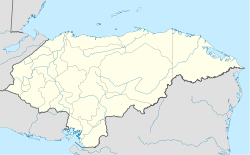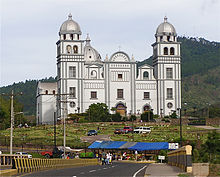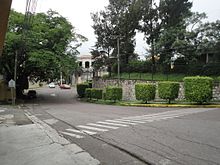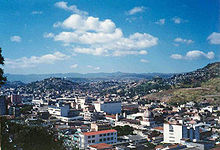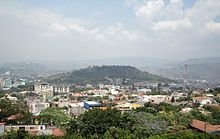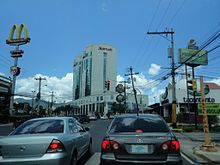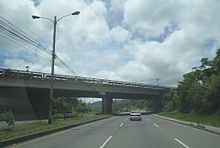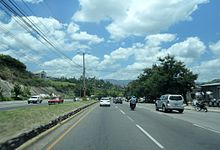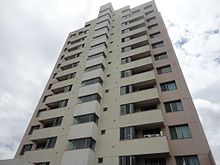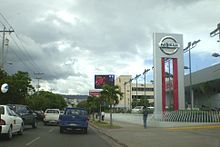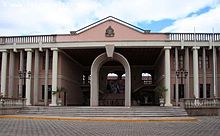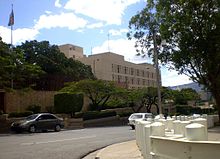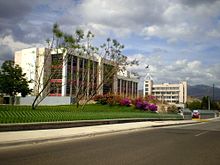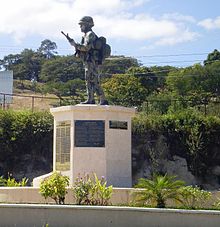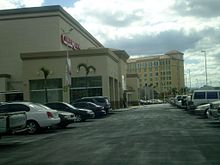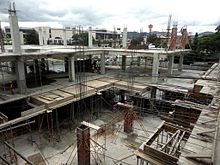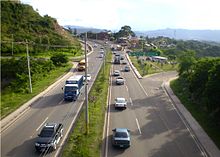- Tegucigalpa
-
Tegucigalpa
Municipio del Distrito Central
Municipality of the Central District— City — Tegucigalpa, M.D.C. Top left: Torre Alianza; top right: Torre Sky Residence; middle: Looking south from Lomas del Mayab; bottom left: Clarion Hotel; bottom right: Torre Lafise. 
Flag
SealNickname(s): Tegus,[1] Tepaz,[2] Cerro de Plata (Silver Mountain)[3] Location of the Central District within the Department of Francisco Morazán Location of Tegucigalpa, M.D.C. in Honduras. Coordinates: 14°6′N 87°13′W / 14.1°N 87.217°W Country  Honduras
HondurasDepartment Francisco Morazán Municipality Distrito Central Founded September 29, 1578 Capital October 30, 1880 Merged as Central District January 30, 1937 Government – Type Mayor-Council – Body Municipal Corporation – Mayor Ricardo Álvarez (PNH)[4] – Vice Mayor Juan Diego Zelaya Aguilar[5] – First Alderman Wilmer Reynel Neal Velásquez[5] Area – City 201.5 km2 (77.8 sq mi) – Central District 1,396.5 km2 (539.2 sq mi) Elevation 990 m (3,250 ft) Population (2010 estimate) – City 1 126 534 – Density 5,604.6/km2 (14,515.8/sq mi) – Metro 1 324 000 – Metro density 948.08/km2 (2,455.5/sq mi) – Demonym Spanish:teguicigalpense, capitalino(a) Time zone Central America (UTC-6) Postal code Tegucigalpa: 11101,[6] Comayaguela: 12101[6] Area code(s) (country) +504 (city) 2[7] Annual budget (2008) 1.555 billion lempiras (US$82,189,029) Website Government of Tegucigalpa Tegucigalpa (Spanish pronunciation: [teɣusiˈɣalpa], formally Tegucigalpa, Municipality of the Central District Spanish: Tegucigalpa, Municipio del Distrito Central or Tegucigalpa, M.D.C. [3]), and commonly referred as Tegus ,[1][8] is the capital of Honduras and seat of government of the Republic, along with its twin sister Comayagüela.[9] Founded on September 29, 1578 by the Spanish,[10] it became the country's capital on October 30, 1880 under President Marco Aurelio Soto.[11] The current Constitution of Honduras, enacted in 1982, names the sister cities of Tegucigalpa and Comayagüela as a Central District to serve as the permanent national capital, under articles 8 and 295.[12][13]
During the short-lived Constitution of the Republic of Central America of 1921, Tegucigalpa served as a Federal District and capital of then-newly formed as one nation: the states of El Salvador, Guatemala and Honduras.[14] After this failed attempt to maintain a Central American republic, Honduras returned to become an individual sovereign nation and on January 30, 1937, Article 179 of the 1936 Honduran Constitution was reformed under Decree 53 to established Tegucigalpa and Comayagüela as a Central District.[15]
Tegucigalpa is located in the southern-central highland region of Honduras[16] in the department of Francisco Morazán of which it is also the departmental capital.[17] It is situated in a valley, surrounded by mountains and both Tegucigalpa and Comayagüela, being sister cities, are physically separated by the Choluteca River.[18] The Central District is the largest of the 28 municipalities in the Francisco Morazán department.[19]
Tegucigalpa is Honduras' largest and most populous city as well as the nation's political and administrative center. Tegucigalpa is host to 25 foreign embassies and 16 consulates[20][21] in addition to being the home base of several state-owned entities such as ENEE and Hondutel, the national energy and telecommunications companies, respectively.[22] The city is also home to the country's most important university, the National Autonomous University of Honduras,[23] as well as the national soccer team.[24] The capital's international airport, Toncontín, is notorious around the world for its extremely short runway for an international airport and the unusual maneuvers pilots must undertake upon landing or taking off to avoid the nearby mountains.[25][26][27]
The Central District Mayor's Office (Alcaldia Municipal del Distrito Central) is the city's governing body,[28] headed by a mayor[29] and 10 aldermen forming the Municipal Corporation (Corporación Municipal).[30] Being the department's seat as well, the governor's office of Francisco Morazán is also located in the capital. In 2008, the city operated on an approved budget of 1.555 billion lempiras (US$82,189,029).[31] In 2009, the city government reported a revenue of 1.955 billion lempiras (US$103,512,220). (More than any other capital city in Central America, except Panama City)
Tegucigalpa's infrastructure has not kept with the population growth.[32] Deficient urban planning,[33] densely condensed urbanization, and poverty[34] are ongoing problems.[35] Heavily congested roadways where current road infrastructure is unable to efficiently handle the over 400 thousand vehicles create havoc on a daily basis.[36] Both current national and local governments have taken approaches at improving or increasing infrastructure as well as to reducing poverty in the city.[37][38]
Contents
Etymology
Most sources indicate that the origin and meaning of the word Tegucigalpa is derived from the Nahuatl language.[39] The most widely accepted version suggests that it comes from the Nahuatl word Taguz-galpa, which translates to cerros de plata in Spanish (hills of silver in English), but this interpretation is uncertain since the natives who occupied the region at time were unaware of the existence of mineral deposits in the area.
Another source suggests that Tegucigalpa derives from another language in which it means painted rocks, as explained by Leticia Oyuela in her book "Minimum History of Tegucigalpa".[40] Other theories indicate it may derive from the term Togogalpa which refers to tototi (small green parrot, in Nahuatl) and Toncontín, a small town near Tegucigalpa (toncotín was a Mexican dance of Nahuatl origin).[41][42]
In Mexico, it is believed the word Tegucigalpa is from the Nahuatl word Tecuztlicallipan, meaning "place of residence of the noble" or Tecuhtzincalpan, meaning "place on the home of the beloved master".[43]
Honduran philologist Alberto de Jesús Membreño, in his book "Indigenous Toponymies of Central America", states that Tegucigalpa is a Nahuatl word meaning "in the homes of the sharp stones" and rules out the traditional meaning "hills of silver" arguing that Taguzgalpa was the name of the ancient eastern zone of Honduras.[44]
History
Tegucigalpa was founded by Spanish settlers as Real de Minas de San Miguel de Tegucigalpa on September 29, 1578 on the site of an existing native settlement of the Pech, Tolupans and the Twahkas.[45] The first mayor of Tegucigalpa was Juan de la Cueva, who took office in 1579.[46] The Dolores Church (1735), the San Miguel Cathedral (1765), the Casa de la Moneda (1780), and the Immaculate Conception Church (1788) were some of the first important buildings constructed.[47]
Almost 200 years later, on June 10, 1762, this mining town became Real Villa de San Miguel de Tegucigalpa y Heredia under the rule of Alonso Fernández de Heredia, then-acting governor of Honduras. The late 1700s and early 1800s saw disruption in Tegucigalpa's local government, from being extinguished in 1788 to becoming part of Comayagua in 1791 to returning to self-city governance in 1817.[48]
In 1817, then-mayor Narciso Mallol started the construction of the first bridge, a ten-arch masonry, connecting both sides of the Choluteca River. Upon completion four years later, it linked Tegucigalpa with her neighbor city of Comayagüela.[49] In 1821, Tegucigalpa legally became a city.[50] In 1824, the first Congress of the Republic of Honduras, declared Tegucigalpa and Comayagua, then the two most important cities in the country, to alternate as capital of the country.[51]
After October 1838, following Honduras' independence as a single Republic, the capital continued to switch back and forth between Tegucigalpa and Comayagua until October 30, 1880, when Tegucigalpa was declared the permanent capital of Honduras by then-president Marco Aurelio Soto.[11] A popular myth claims that the society of Comayagua, the long-time colonial capital of Honduras, publicly disliked the wife of President Soto, who took revenge by moving the capital to Tegucigalpa.[52] A more likely theory is that the change took place because President Soto was an important partner of the Rosario Mining Company, an American silver mining company, whose operations were based in San Juancito, close to Tegucigalpa, and he needed to be close to his personal interests.[53]
By 1898, it was decided that both Tegucigalpa and Comayagüela, being neighbor cities on the banks of the Choluteca River, would form the capital, but with separate names and separate local governments.[54] During this period, both cities had a population of about 40,000 people.
Between the 1930s and 1960s, Tegucigalpa continued to grow reaching a population of over 250,000 people, giving way to what would become one of the biggest neighborhoods in the city, the Colonia Kennedy; the nation's autonomous university, the UNAH; and the construction of the Honduras Maya Hotel.[55] It still remained relatively small and provincial until the 1970s, when migration from the rural areas began in earnest. During the 1980s, several avenues, traffic overpasses, and large buildings were erected, a relative novelty to a city characterized until then by two-story buildings.[56] However, lacking the enforcement of city planning and zoning laws, it led to highly disorganized urbanization. This lack of proper urbanization as the population has grown is evident on the surrounding slopes of the several hills in the city where some of the city's most impoverished neighborhoods have prevailed.[57]
On October 30, 1998, Hurricane Mitch devastated the capital, along with the rest of Honduras.[58] For five days, Mitch pounded the country creating devastating landslides and floods, causing the death of thousands as well as heavy deforestation and the destruction of thousands of homes.[59] A portion of Comayagüela was destroyed along with several neighborhoods on both sides of the Honduran capital. After the hurricane, infrastructure in Tegucigalpa was severely severed. Even 12 years later, remnants of Hurricane Mitch are still visible specially along the banks of the Choluteca River.[60][61]
Today, Tegucigalpa continues to sprawl far beyond its former colonial core: towards the east, south and west, creating a large but disorganized metropolis. In an effort to modernize the capital, increase its infrastructure and improve the quality of life of its inhabittants, the current administration has passed several ordinances and projects to turn the city around within the upcoming years.[62]
Geography
Tegucigalpa is located on a chain of mountains at elevations of 935 metres (3,068 ft) on its lowest points and 1,463 metres (4,800 ft) on its highest suburban areas. Like most of the interior highlands of Honduras, the majority of Tegucigalpa's current area was occupied by open woodland. The area surrounding the city continues to be open woodland supporting pine forest interspersed with some oak, scrub, and grassy clearings as well as needle leaf evergreen and broadleaf deciduous forest.
The metropolitan area of both Tegucigalpa and Comayagüela cover a total area of 77.6 square miles (201 km2) while the entire Municipality of the Central District covers a total area of 539.1 square miles (1,396 km2).[63] Geological faults have been identified in the District's high regions surrounding the capital which are a threat to the neighborhoods on and below the hills.[64]
The Choluteca River, which crosses the city from north to south, physically separates Tegucigalpa and Comayagüela.[65] El Picacho Hill, a rugged mountain of moderate height convert rises above the downtown area; several neighborhoods, both upscale residential and lower income, are located on its slopes. The city consists of gentle hills, and the ring of mountains surrounding the city tends to trap pollution.[66] During the dry season, a dense cloud of smog lingers in the basin until the first rains fall.
Tucked in a valley and bisected by a river makes Tegucigalpa prone to flooding during the rainy season, as experienced to the fullest during Hurricane Mitch and to a lesser degree every year during the rainy season. Despite being several thousand feet above sea level, the city currently lacks an efficient flood control system, including canals and sewerage powerful enough to channel rain water back into the river to flow down to the ocean. The river itself is a threat since it isn't deep enough below the streets nor there are levies high enough to prevent it from breaking out.[67] There are currently more than 100 neighborhoods deemed zones of high risk, several of them ruled out as uninhabitable in their entirety.[57]
There is a reservoir, known as Embalse Los Laureles, west of the city providing 30 percent of the city's water supply as well as a water treatment plant south of the city about 7.3 kilometres (4.5 mi) from the airport; part of the Concepción Reservoir just 6 kilometres (3.7 mi) southwest of the water plant.[68]
See also: Choluteca river basin and Water management in greater TegucigalpaThe Central District shares borders with 13 other municipalities of Francisco Morazán:[19] (to the north) Cedros and Talanga; (south) Ojojona, Santa Ana, San Buenaventura and Maraita; (east) San Juan de Flores, Villa de San Francisco, Santa Lucía, Valle de Ángeles, San Antonio de Oriente, and Tatumbla; (and to the west) Lepaterique. It is also bordered on the west by two municipalities of the Comayagua Department, Villa de San Antonio[69] and Lamaní, with the latter exactly at the quadripoint where the Central District, Lepaterique, Villa de San Antonio and Lamaní all meet.
Climate
Teguicigalpa features a more moderate form of a tropical wet and dry climate. Of the major Central American cities, Tegucigalpa's climate is among the most pleasant due to its high altitude.[70] Like much of central Honduras, the city has a tropical climate, though tempered by the altitude—meaning less humid than the lower valleys and the coastal regions—with even temperatures averaging between 19 °C (66 °F) and 23 °C (73 °F) degrees.[71]
The months of December and January are coolest, with an average min/ low temperature of 14 °C (57 °F); whereas March and April—popularly associated with Holy Week's holidays—are hottest and temperatures can reach up to 40 °C (104 °F) degrees on the hottest day.[72] The dry season lasts from November through April and the rainy season from May through October.[73] There is an average of 107 rainy days in the year, June and September usually the wettest months.
The average sunshine hours per month during the year is 211.2 and the average rainy days per month is 8.9. The average sunshine hours during the dry season is 228 per month while 182.5 millimetres (7.19 in) is the average monthly precipitation during the wet season. The wettest months of the rainy season are May—June and September—October, averaging 16.2 rainy days during each of those periods.
Climate data for Tegucigalpa (Tegucigalpa Airport) Month Jan Feb Mar Apr May Jun Jul Aug Sep Oct Nov Dec Year Average high °C (°F) 25.7
(78.3)27.4
(81.3)29.5
(85.1)30.2
(86.4)30.2
(86.4)28.6
(83.5)27.8
(82.0)28.5
(83.3)28.5
(83.3)27.3
(81.1)26.0
(78.8)25.4
(77.7)27.9 Daily mean °C (°F) 20.0
(68.0)20.9
(69.6)22.5
(72.5)23.6
(74.5)24.2
(75.6)23.4
(74.1)22.9
(73.2)23.2
(73.8)23.2
(73.8)22.4
(72.3)21.1
(70.0)20.2
(68.4)22.2 Average low °C (°F) 14.3
(57.7)14.5
(58.1)15.5
(59.9)17.1
(62.8)18.2
(64.8)18.2
(64.8)18.0
(64.4)18.0
(64.4)17.9
(64.2)17.6
(63.7)16.3
(61.3)15.0
(59.0)16.7 Precipitation mm (inches) 3.2
(0.126)4.9
(0.193)6.9
(0.272)25.9
(1.02)117.2
(4.614)249.5
(9.823)180.6
(7.11)181.6
(7.15)235.2
(9.26)131.0
(5.157)42.6
(1.677)7.6
(0.299)1,186
(46.69)Avg. rainy days 4 2 1 3 14 18 10 10 17 16 8 4 107 Sunshine hours 220.3 229.6 267.1 243.7 215.6 173.4 192.1 206.2 182.8 196.8 196.8 210.9 2,535.3 Source no. 1: worldweather.org;[74] Source no. 2: weather-and-climate.com (Sunshine hours)[75] climatetemp.info (Avg. rainy days)[76] Hurricane Mitch
Main article: Hurricane MitchTegucigalpa, as with the rest of Honduras, experienced significant damaged by Hurricane Mitch, something of a magnitude Hondurans had not witnessed since Hurricane Fifi. Mitch destroyed part of the Comayagüela section of the city, as well as other places along the banks of the Choluteca River. The storm remained over Honduran territory for five days, dumping heavy rainfall late in the rainy season. The ground was already saturated and could not absorb the heavy precipitation, while deforestation and debris left by the hurricane led to catastrophic flooding throughout widespread regions of the country, especially in Tegucigalpa.[77]
The heavy rain caused flash floods of Choluteca's tributaries, and the swollen river overflowed its banks, tearing down entire neighborhoods and bridges across the ravaged city. The rainfall also triggered massive landslides around El Berrinche Hill, close to the downtown area. These landslides destroyed most of the Soto neighborhood, and debris flowed into the river, forming a dam. The dam clogged the waters of the river and many of the low-lying areas of Comayagüela were submerged; historic buildings located along Calle Real were either completely destroyed or so badly damaged that repair was futile.[78]
Cityscape
Situated in a valley and surrounded by mountain ranges, Tegucigalpa is hilly with several elevations and few flat areas. The city is also highly disorganized, particularly around its oldest districts.[79][80][81] It has seen a rapid growth in the last 30 years[82] and only until recently has the government passed certain laws to establish city planning and zoning rules.[83] Surface roads can be narrow with the most important avenues carrying no more than two or three lanes running in each direction, adding to the problem of heavy traffic congestion. Several of the main boulevards have been equipped with interchanges, overpasses and underpasses, allowing for sections of controlled-access highways but considering that even the city's beltway does not entirely circle the city, the roads are generally limited-access. Intense webs of electrical and telephone lines above the streets are a common site in the capital, and virtually in all Honduran cities, since implementation of underground utility lines has only been adopted in the recent years.
Around the city
The metropolitan area of Tegucigalpa and Comayagüela is officially divided into barrios and colonias and there are currently 892 of them. Colonias represent relatively recent 20th-century middle class residential suburbs, some known as residenciales for their upper income development, and these are continuously spreading while the barrios are old inner-city neighborhoods.
While the city administration divides the capital into barrios and colonias, the fact that there are hundreds of them, makes it difficult to define the city's different regions, especially for those not familiar with the Central District. To have a better understanding of the city's regions, the metro area of the Central District can essentially be divided, first, into two sections: Tegucigalpa and Comayagüela. These two entities remain separated by the Choluteca River basin that runs between them.
Tegucigalpa
The Tegucigalpa side of the District can be divided into five sections: 1) Centro Histórico (Historic Downtown); 2) Centro Contemporáneo or Zona Viva (Contemporary Downtown or Vibrant Zone); 3) North Tegucigalpa; 4) South Tegucigalpa; and 5) East Tegucigalpa:
- 1 - Centro Histórico or the Historic Downtown of Tegucigalpa is formed by the original neighborhoods that date back to its founding days. For years, this area remained neglected and rundown but in recent times, attempts have been made to revive the zone and bring back its colonial heritage. Several government offices, including the National Congress and City Hall as well as museums, parks, a cathedral and churches are located here.
- 2 - Centro Contemporáneo is the contemporary, vibrant and modern downtown of Tegucigalpa. This area is formed by the neighborhoods encompassed east of the Choluteca River, south of the northern tributary, Rio Chiquito (which confluences with the Choluteca below the Mallol Bridge), west of the beltway (Anillo Periférico), and north of Armed Forces Blvd.
This section of the city is perhaps the best developed and properly urbanized. It is formed by more than 40 neighborhoods, many of them wealthy middle class residential areas such as Colonia Palmira to the east of the historic center, on Boulevard Morazán which hosts several foreign embassies as well as upscale restaurants. Other upscale neighborhoods are Lomas del Guijarro, Loma Linda and Lomas del Mayab which house most of the apartment complexes in the city.
The leading hotels of the city are found around these neighborhoods, including within the Plaza San Martín Hotel District. These include: Marriott Hotel, Clarion Hotel, Hotel El Centenario, Intercontinental, Honduras Maya, Plaza Del Libertador, Plaza San Martín, Hotel Alameda, Excelsior Hotel and Casino.[84][85]
Boulevard Morazán and Avenida Los Próceres/Avenida La Paz are busy commercial corridors (running parallel of each other) and run through several neighborhoods home to foreign embassies, a hotel district, business establishments and corporate buildings; including the Los Próceres Comercial Park (Parque Comercial). Boulevard Suyapa and Boulevard Juan Pablo II are located south of the aforementioned boulevards and they also form a busy commercial and financial district stretching through several neighborhoods such as Colonia Los Profesionales where the Presidencial House is located; Colonia Florencia Norte where Multiplaza Mall is located; Colonia Miramontes, among others—housing several financial institutions, government offices, hotels, etc.
- 3 - North Tegucigalpa is formed by both middle class and impoverished neighborhoods that lie above the surrounding hill immediately north of the historic downtown. Beyond these neighborhoods sits the United Nations National Park on the El Picacho Hill, one of the most popular destinations in the capital among its residents and visitors. Pass beyond the Park, stretching north and northwest of the city, upper income suburban neighborhoods such as El Hatillo, sit on the sides of the hills, surrounded by heavy vegetation.
- 4 - South Tegucigalpa is everything south of Boulevard Fuerzas Armadas. This area is home to Colonia Kennedy, the capital's largest neighborhood with more than 137,000 residents. South Tegucigalpa concentrates both middle class and poor neighborhoods. Two universities, UTH and UNITEC, are located just off the beltway in southern outskirt neighborhoods.
- 5 - East Tegucigalpa concentrates mostly rural and impoverished neighborhoods, the result of improvised growth with little government funding and involvement. María Pediatric Hospital and the Basílica of Suyapa lie on the side of Anillo Períferico's eastern stretch.
Comayagüela
Most of Comayagüela is made up of lower income neighborhoods. Historically, Comayagüela has remained less developed than the other side of the capital, some citing insufficient contribution from public officials. In recent years, this western side of the capital has seen some growth and improvement such as the opening of Metromall near the airport. With the construction of City Mall, to become the largest mall in the country, Comayagüela will be receiving another upgrade. There are an estimated 650,000 residents in Comayagüela contributing 58.3 percent of the 120 million lempiras (US$6.349 million) generated every day by commerce in the Central District.
The Comayagüela side of the capital can be divided into four sections: 1) Zona Centro (Downtown Comayagüela); 2) North Comayagüela; 3) South Comayagüela; and 4) West Comayagüela:
- 1 - Zona Centro de Comayagüela is the downtown area of Comayagüela and also original founding grounds formed by its oldest barrios. These barrios are formed in a grid street plan style. Several government offices are located in this district, including the Central Bank of Honduras Annex building and the Criminal Bureau of Investigation (Dirección General de Investigación Criminal).
- 2 - North Comayagüela is formed by relatively recent post-Hurricane Mitch middle class residential developments that stretch onto the northern hills of Comayagüela, such as Colonia Cerro Grande, a continuously growing middle class neighborhood on the northern outskirts.
- 3 - South Comayagüela is by far the better-off region of Comayagüela. This area is found south and southwest of the airport, around Los Laureles Reservoir and south of Lepaterique Road (Carretera Lepaterique also known as Carretera al Batallón). Also a post-Hurricane Mitch area, it has grown in the last decade and includes some of Comayagüela's upper income communities that have erupted in the area and continues to spread out as newer suburban middle class developments are built. Toncontín International, Metro Mall and upcoming City Mall are located in this area. Residencial la Arboleda and Residencial los Hidalgos are some of the growing upper income developments in the southern outskirts of Comayagüela.
- 4 - West Comayagüela is mostly impoverished neighborhoods spreading away from Zona Centro onto the surrounding slopes. Many of these neighborhoods came to be through improvised urbanization and lack proper infrastructure. This area prevails north of Lepaterique Road and westward of Boulevard de la Comunidad Europea (European Community Blvd).
Arterial roads
The Anillo Periférico (beltway) and Boulevard Fuerzas Armadas (Armed Forces Blvd) are the city's two expressways, equipped with center dividers, interchanges, overpasses and underpasses—allowing for controlled-access traffic. These connect with the city's other major boulevards (Central America Blvd, Suyapa Blvd, European Community Blvd, Kuwait Blvd) which are essentially limited-access roadways as they have been equipped with interchanges but lack underpasses and overpasses to bypass crossing surface road traffic.
Despite a network of major highways, none reach directly into the historic downtown and while having been improved with grade separations, drivers rely heavily on surface streets to move about the city, including reaching the downtown area. Like in most Central American cities, there doesn't seem to be much rhyme or reason as to how streets are named, making orientation and driving rather difficult to first-time visitors to the city.[86] The current city administration has green lit several road infrastructure projects to help reduce traffic congestion and improve the overall aspect of the city.[87]
Demographics
Historical populations Year Pop. ±% 1901 24,000 — 1961 164,941 +587.3% 1974 302,483 +83.4% 1988 595,931 +97.0% 2001 850,445 +42.7% 2004 874,515 +2.8% 2006 920,366 +5.2% 2010 1,126,534 +22.4% source:[88][89] As of 2011, following the trend of population growth between 1988 and 2001 of 2.79 percent, the population of Tegucigalpa is estimated anywhere between 1.2 and 1.3 million people.[90] Tegucigalpa's population and metro area is expected to double by 2029.[91]
The 2010 Population Projections estimated that the Central District had a population of 1,126,534 residents,[92] continuing a trend of population growth in the city since the 2001 Census, which recorded 850,445 residents.[93] In 2010, the average monthly income was L.8,321 (US$440.49), compared to the total national average of L.4,767 (US$252.35) and the national urban zone average of L.7,101 (US$375.91).[94][95] 4.9 percent of the population is illiterate, compared to the national rate of 15.2 percent.[96]
The Human Development Index (HDI) is the highest in the country at 0.759 in 2006. In 2006, 47.6 percent of the Central District's population lived in poverty—29.7 lived in moderate poverty and 17.9 in extreme poverty. Life expectancy in the District as of 2004 is 72.1 years. In 2004, there were 185,577 households with an average of 4.9 members per household.[97]
The ethnic and racial makeup of Tegucigalpa is strongly tied to the rest of Honduras.[98] 90 percent of the city-dwellers are predominantly mestizos with a small White-Hispanic minority. They are joined by Chinese[99] and Arab immigrants,[100] the latter mostly from Palestine.[101] There are indigenous Amerindians and Afro-Honduran people as well.
Tegucigalpa by numbers:[102] 4 theaters, 12 marketplaces, 12 pedestrian bridges, 12 universities, 14 hospitals, 14 museums, 28 supermarkets, 40 movie screens, 64 health centers, 64 signal light-controlled intersections, 87 middle school and high schools, 100 farmacies, 123 local emergency committees, 170 restaurants, 200 parks and plazas, 200 sports facilities, 400 firemen, 600 volunteer workers, 892 neighborhoods classified as barrios and colonias, 1,200 physicians, two thousand public transportation vehicles, 12 thousands taxis, 60 thousand illiterates, and 140 thousand with direct access to potable water only.
Economy
 HSBC main offices on Suyapa Blvd (former BGA bank building).
HSBC main offices on Suyapa Blvd (former BGA bank building).
The Central District has an economy equal to 19.3 percent of country's GDP. The District's active labor force is of 367,844 people of which 56,035 are employed in the public sector. There are 32,665 business establishments throughout the capital, the most of any city in the country. The city's major economic sources are commerce, construction, services, textiles, sugar, and tobacco.[103] In 2009, the city's revenue and expenditures budget was of L.2,856,439,263 (US$151,214,182)[104] while in 2010 it was of L.2,366,993,208 (US$125.204.606)[105][106] In 2009, the unemployment rate in Tegucigalpa was 8.1 percent.[107] and an unemployed person may spend up to four months seeking employment.[108]
Economic activity in the capital is broken down as follow: commerce—including wholesale, retail, auto repair, hardware (42.86%); manufacturing industry (16.13%), hospitality—hotels and restaurants (14.43%), banking and real state (10.12%), social and personal services (8.94%), health-related services (3.90%), and others (3.60%).[109]
The industrial production taking place in the region include textiles, clothing, sugar, cigarettes, lumber, plywood, paper, ceramics, cement, glass, metalwork, plastics, chemicals, tires, electrical appliances, and farm machinery. Maquiladora duty-free assembly plants have been established in an industrial park in the Amarateca valley, on the northern highway.[110] Silver, lead and zinc are still mined in the outskirts of the city.[111]
Banking
Honduran banks based in Tegucigalpa include Banco Atlántida (Bancatlan), Banco Continental, Banco Financiera Centroaméricana (Ficensa), Banco Financiera Comercial Hondureña (Ficohsa), Banco Hondureño del Café (Banchcafe), Banco Hondureño para la Producción y la Vivienda (Banhprovi), Banco de Occidente, Banco del País, Banco de los Trabajadores, and the Central Bank of Honduras, the country's central banking public institution.
International financial institutions in Tegucigalpa include Banco de América Central-BAC Honduras (former Banco Mercantil-BAMER), Banco Lafise (Latin American Financial Services), Citibank, HSBC, the Inter-American Development Bank (IAB), the World Bank, and the Central American Bank for Economic Integration (BCIE), with its headquarters located in Colonia Miramontes on Boulevard Suyapa.[112]
Foreign investment
Manufacturing assembly plants (maquiladoras) were introduced in Honduras in 1976.[113] While their contribution to the economy remained small, they boomed at the beginning of the 1990s, mostly concentrating in northern Honduras but after the mid 1990s they were expanded to the central region, including Tegucigalpa. By 2005, at least 6 maquiladoras operated in the Central District.[114]
By the end of the 1990s and early 2000s, Tegucigalpa continued to be a focus city for the development of industrial parks. The main obstacle to establish factories in Tegucigalpa has been facilitating infrastructure to provide efficient access between the capital and country's economic hubs: San Pedro Sula and Puerto Cortez.[115]
While foreign investment manufacturers and exporters have focused in northern Honduras, the presence of multinational corporations is evident in Tegucigalpa. Popular retail, restaurant, and hospitality American-branded franchises prevail throughout the Honduran capital; such as Walmart, McDonalds, Marriot, among others. Companies from other countries such as Mexico, have also made their presence with arrivals like Cinépolis movie theaters, which opened in 2010 in Cascadas Mall.[116] Foreign real estate and property developers operate in the capital District as well, such as Grupo Roble of the Multiplaza malls.
Tegucigalpa's economic challenges are tied to those of the rest of the country, such as overcoming crime, anomalies in the judicial system, educational backwardness, and deficient infrastructure in order to continue to encourage foreign investors and permit growth of local entrepreneurs.[117]
Government
As capital of Honduras, as department head and as a municipality, the Central District seats three separate governments: national, departmental and municipal.[118] Prior to 1991, the central government held great jurisdiction over the execution of city management across the country, leading to uneven representation and improper distribution of resources and governance.[119] As a result, in late 1990, under Decree 134-90, the National Congress of Honduras enacted the Law of Municipalities (Ley de Municipalidades), defining the country's department and municipal institutions, representatives and their functions to give city government autonomy and decentralize it from the national government.[120]
While autonomous, the Central District is still influenced by the national government given the territory remains seat of government of the republic. Major changes in public policy and funding of major city projects usually reach the Office of the President prior to approval by the District's local government.[121]
National and departmental governments
Tegucigalpa is the political and administrative center of Honduras.[122] It is also the seat of government of the Francisco Morazán department.[123] All three branches of the national government as well as their immediate divisions—including the 16 departments of the Executive Branch,[124] the National Congress,[125] the Supreme Court of Justice,[126] the Armed Forces and National Police headquarters—are located in the city. Most public agencies and state-owned companies are headquartered in the capital as well.[22]
Local government
City government takes form in a mayor-council system and is regulated under the Law of Municipalities which came into effect on January 1, 1991. The Central District Municipal Government (Alcaldía Municipal del Distrito Central or AMDC) is the city's governing authority. As established by current city governing law, AMCD is structured as a municipal corporation, which is the deliberative-legislative body, voter-elected, and highest authority within the municipality.[127]
The Municipal Corporation is formed by a mayor serving as chief executive and general administrator and legal representative of the municipality[128] and a vice mayor to serve as acting mayor when required and to oversee functions within AMDC as instructed by the mayor.[129] The current mayor of the Central District is Ricardo Álvarez (PNH)[130] who is serving his second term (2006–2010, 2010–2014) after winning reelection in 2009.[131] Alvarez is the first candidate to win a consecutive reelection, he is the seventh person to serve as mayor of the Central District since local elections were restored in 1986, (prior to 1986, the Central District local government, known as Consejo Metropolitano (Metropolitan Council), was appointed by the President); and this is the eight elected mayoral term since then.
Ten aldermen (regidores) are also members of the Municipal Corporation who along with the mayor execute the duties as described in the Law of Municipalities, including management, budgeting, and local law and ordinance legislation.[132] Six of the current aldermen belong to the National Party while another two belong to the Liberal Party; one alderman belongs to the Democratic Unification Party and the other is Independent.[133]
Both the city mayor and aldermen are elected to 4-year terms by voters of the Central District. Removal of the mayor or any aldermen for any cause is reserved to the Secretary of State in the Ministry of Interior and Justice (Secretaría de Gobernación y Justicia).[134] The Municipal Corporation also counts with a Municipal Development Council (Consejo de Desarrollo Municipal) which serves as an advising cabinet on all the areas of issues of the city such as human development, public safety, utilities, etc.[135]
Law enforcement in the city falls under the National Preventive Police (Policía Nacional Preventiva) and its sub-division, the Municipal Police (Policía Municipal), one with nationwide jurisdiction while the other serves as local police.[136][137] The State Attorney (Procuraduria Estatal) and the Attorney General (Ministerio Público) are in charge of crime prosecution at the national and departmental level.[138] The Municipal Court (Juzgado de Justicia Municipal) handles cases at the local level.
Central District
For all practical purposes the capital of Honduras is Tegucigalpa. However, politically and officially speaking, the Municipality of the Central District (DC for short) is the capital of Honduras and Tegucigalpa and Comayagüela are two entities within the district.[9] Traditionally, they are regarded as twin or sister cities in part because they were originally founded as two distinct cities.[139] When the Central District was formed on January 30, 1937 under Decree 53 of reformed Article 179 of the 1936 Honduran Constitution, both cities became one political entity sharing the title of Capital of Honduras.[15]
The current Constitution of Honduras, under Chapter 1, Article 8, states (translated), "The cities of Tegucigalpa and Comayagüela, jointly, constitute the Capital of the Republic."[12] Furthermore... Chapter 11, Article 295, states (translated) "The Central District consists of a single municipality made up of the former municipalities of Tegucigalpa and Comayagüela";[13] however, municipalities in Honduras are defined as political entities similar to counties, and they may contain one or more cities. For example, in the Department of Atlántida, La Ceiba is the largest city—being also the third largest in Honduras—both in terms of population and metropolitan area;[140] however, Tela, one of the eight municipalities of Atlántida, is the biggest municipality in terms of physical administrative area in that department.[141] Since the Municipality of Tela is not considered the entire city of Tela, it is not bigger than La Ceiba. There are an additional of 41 villages and 293 hamlets through the Central District Municipality.[63] These may be assigned deputy mayors (alcalde auxiliar) to serve as local representatives.
Culture
Tegucigalpa is a colonial city with a history spanning for more than 400 years. According to the National Chamber of Tourism of Honduras (CANATURH), the city is visited by at least 250,000 tourists every summer.[142] For Easter 2011, at least 300,000 visitors arrived to the city.[143]
The Fair of the Capital (Feria de la Capital or Feria capitalina) is a celebration happening every year in the month of September to commemorate the city's anniversary. Several festivities occur during this time including book fairs, art expositions, concerts and a parade. The 2010 Fair was suspended due to heavy rain and flooding in the region.[144] For 2011, the fair was scheduled to run from September 26 until October 13.[145] Another yearly event is the Fair of the Horse and Culture (Feria del Caballo y la Cultura) taking place in the month of November. There is also a Christmas Fair in the month of December.
Parks and landmarks
Statue of Francisco Morazán in Central Park.
Some of the parks in the city include Parque La Leona, Parque Herrera, Parque Del Soldado, Parque Juan A. Lainez, Plaza España, Plaza del Libertador, and Central Park, the latter located in the heart of the historic center which leads to Paseo Liquidambar, a pedestrian zone street.[146] La Tigra National Park lies several kilometers north of the city and covers an area of 93.9 square miles (243 km2). The United Nations National Park on El Picacho Hill just north above the city offers a great view of the city and hosts the Picacho Metropolitan Zoo.
Some of the popular landmarks include the Metropolitan Cathedral, the former Presidential Palace (now a museum), the National University, the Basilica of the Virgin of Suyapa, La Merced Church, and the Manuel Bonilla Theater.[147]
There are several charming colonial villages within easy driving distance from Tegucigalpa: Santa Lucia (12 km/7 mi away), Valle de Angeles (21 km/13 mi away), Ojojona, Yuscarán and San Juancito. Each has its own distinct character and sense of history and all of them make easy day-trips out of the city.
Media
Tegucigalpa is home to two of the nation's four most important newspapers:[148][149] La Tribuna, the liberal and leading newspaper in the city[150] and El Heraldo, the more conservative.[151] There are three other daily papers printed in the city: El Libertador, El Patriota, and Tiempos del Mundo. Hondudiario, Proceso Digital, and Honduras Weekly are online-only newspapers based in the capital, the latter offered in English. La Gaceta is the Honduran government's official newspaper, printed and published in the capital.[152]
Tegucigalpa is also served by the rest of country's newspapers, including La Prensa and El Tiempo from San Pedro Sula[153] and the sports newspaper and fashion magazine, Diez[154] and Estilo, respectively; divisions of La Prensa. Voz el Soberano and Revistazo are political watchdog online publishers.[155]
There are currently eight channels broadcasting on VHF (3, 5, 6, 7, 8, 9, 11, 13) and 12 channels on UHF (21, 30, 33, 36, 39, 45, 48, 51, 54, 57, 66, 69) in the Central District region from TV networks of the major cities in the country. There are five television networks based in Tegucigalpa: Televicentro Corporation, the largest television media conglomerate in the country which operates three television networks: Compañia Televisora Hondureña (Channel 5), Telesistema Hondureño (channels 3 & 7) and Telecadena 7 & 4 (Channel 7);[156] Channel 11[157] owned by Grupo Continental & R. Media;[158] Televisión Educativa National-TEN (Channel 10), a public broadcasting network[159] featuring the Telenoticiero Abriendo Brecha[160] newscast, Maya TV (Channel 66),[161] and Telered 21 which has its principal offices in San Pedro Sula. Cable Color, based in Tegucigalpa, is one of the major cable TV providers in the country.[162]
There are 24 FM radio stations and 28 AM stations transmitting into or from Tegucigalpa.[163][164] Emisoras Unidas,[165] the largest radio conglomerate in the country, is headquartered in Tegucigalpa and operates 94-SU 94.1 FM, Rock N' Pop 92.3 FM, Vox 101.9 FM, Suave 102.5 FM, Sterio Éxitos 88.1 FM, Radio Satélite 790 AM, XY Honduras 90.5 FM, Radio HRN 92.9 FM.[166]
The following radio stations are based in Tegucigalpa: 88.7 Radio Globo Honduras,[167] 91.1 Radio Kairos, 91.7 Estereo La Buenisima, 93.5 Radio Cadena Voces,[168] 94.7 Radio America,[169] 95.9 Radio Panamericana, 97.1 La 97 FM Radio, 97.7 Stereo Azul, 100.1 Super 100 Estereo, 101.3 Radio Nacional de Honduras, 103.1 Tu Alternativa, 103.7 Stereo Luz,[170] 104.3 Momentos FM Estereo, 104.9 Estereo Amor,[171][172] 106.7 Radio CHN-Cadena Hondureña de Noticias, and 107.3 W-107 Radio del Flow.
Museums
There are 14 museums in Tegucigalpa. Most of the popular museums are located around historic center of the city. These include the National Identity Museum (Museo para la Identidad Nacional), founded in 2006; the National Anthropology and History Museum or Villa Roy National Museum (Museo Nacional de Antropología e Historia-Museo Nacional Villa Roy), founded in 1976 on the former residence of President Julio Lozano Díaz (1954–1956) and reopened after a complete restoration in 1997;[173] the National Art Gallery (Galería de Arte Nacional), founded in 1996;[174] the Republic History Museum (Museo Histórico de la República), founded in 1993;[175] the Museum of Man (Museo del Hombre), founded in 1989,[175] the Telecommuncations Museum (Museo de las Comunicaciones), founded in 1985; the Military History Museum (Museo Histórico Militar), founded in 1983;[175] and the Archaeological Museum (Museo Arqueológico).
The Natural History Museum (Museo de la Historia Natural) is located within the National Autonomous University of Honduras.[176] The Numismatic Museum (Museo Nimismático Rigoberto Rojas) was founded in 1993 and is located in Comayagüela next to the Central Bank of Honduras Annex building.[177] There is a children's museum, (Centro Interactivo de Enseñanza CHIMINIKE), founded in 2003, located on Blvd. Fuerzas Armadas within the Government Civic Center complex, which also houses the Foreign Affairs Ministry, the Supreme Court of Justice and the Magistrates' Courts.
Other places of cultural interest are the Colonial Museum (Museo Colonial) located in Casa Cural, the Cultural Center of Spain in Tegucigalpa - CCET, founded in 2007; and Sala Bancatlán, located in Plaza Bancatlán of Banco Atántida.[175] The Honduran Institute of Anthropology and History, founded in 1952, promotes cultural heritage and manages several museums throughout Honduras.[178] There is an art and history museum, Santa María de los Ángeles, in Valle de Ángeles, 27 km/17 mi northwest of Tegucigalpa.[179]
Cuisine
Main article: Cuisine of TegucigalpaThere is a variety of restaurants of different cuisine styles and origin in Tegucigalpa. Locals and visitors alike can enjoy of several restaurants serving traditional Honduran dishes as well, either from a typical streetside vendor or family restaurant to upscale food establishments.[180]
Shopping centers
The centre of shopping in Tegucigalpa is Multiplaza, a multi-level indoor shopping mall that includes design name stores, a major grocery store, a movie theater complex, restaurants, and banking. This mall is located on John Paul II Blvd, forming one of the busiest commercial districts in the capital around the John Paul II Blvd and Suyapa Blvd corridors (running parallel to each other) and Central America Blvd (crosswise). Other busy corridors are the Francisco Morazán Blvd and Los Próceres Ave/La Paz Ave to the north of the city.
Shopping malls of considerable size in Tegucigalpa include:
- City Mall (Opening 2012)
- Multiplaza
- Mall El Dorado
- Mall Las Cascadas
- Mall Premier (Opening 2012)
- Metromall
- Paseo Los Castaños
- Paseo Los Próceres
- Plaza America
- Plaza Millenium
- Plaza Miraflores
- Plaza Nova
Tegucigalpa will be home of the largest shopping mall in Central America after the opening of City Mall in early 2012.[181][182][183]
Sports
Tegucigalpa is home to Club Deportivo Olimpia and Club Deportivo Motagua, members of the Honduran National Soccer League. Between the two teams, they have won more than 30 championships. The Tiburcio Carias Andino National Stadium is the multi-purpose venue hosting the national and international soccer games taking place in the capital. Inter-city school sports championships take place in Tegucigalpa as well.[184]
The National College of Engineers Coliseum, west of the city near UNAH, is a basketball arena occasionally fitted as a music concert venue as well.[185] There is a sports facility known as Olympic Village Sports Complex (Complejo Deportivo Villa Olímpica) hosting several Olympic sports such as boxing, archery, tennis and tae-kwon-do; it is located north of the National University-UNAH.[186]
Education
Tegucigalpa serves as the national education center, hosting most of the universities and higher education institutions in the country. The public and private education system in Tegucigalpa is divided into 16 school districts (distritales).[187] All districts are part of the Department of Francisco Morazán Education Managament (Dirección Departamental de Educación), which in turn is a part of the country's Secretary of Education.[188]
There are 1,235 public schools in the Central District broken down as 488 preschools, 563 elementary schools, and 184 middle and high schools. In 2003, there were a total of 287,517 students enrolled throughout the municipality—28,915 in preschool, 159,679 in elementary school, and 98,923 in middle or high school.[97] There are about 147 bilingual schools in Tegucigalpa.[189]
There are two modalities in regards to the school calendar: American Period (August to July), mostly used by private and bilingual schools; and Latin Period (February to November), used by public schools.[190]
Universities
There are 12 universities in Tegucigalpa, including three state-funded higher education institutions.[191] The National Autonomous University of Honduras (UNAH), founded in 1847, is the country's most important university which also operates regional campuses in several other cities in the country, including San Pedro Sula and La Ceiba.[192] The other two publicly-funded institutions are Francisco Morazán National Pedagogic University (UPNFM), founded in 1989, focusing on preparing future educators in several disciplines.[193] and the National Institute of Professional Formation (INFOP), founded in 1972, focusing on economic and social development disciplines.
There are 10 private universities in Tegucigalpa. These include the Pan-American Agricultural School (Zamorano), located in Zamorano valley, 30 km (19 mi) east of the city, founded in 1941;[194] José Cecilio del Valle University (UJCV), founded in 1979;[195] Technological University of Honduras (UTH), founded in 1986;[196] Central American Technological University (UNITEC), founded in 1987 in Jacaleapa,[197] member of Laureate International Universities;[198] Catholic University of Honduras (UNICAH), founded by the Catholic Church in 1992;[199] Center of Design, Architecture, and Construction (CEDAC), founded in 1996; Metropolitan University of Honduras (UMH), founded in 2001; New Millenium Christian-Evangelic University (UCENM-Tegucigalpa Campus), founded in 2001; Polytechnic University of Honduras (UPH), founded in 2006; and the Polytechnic University of Engineering (UPI), founded in 2007. There is also two higher education centers: the Technological University Center (CEUTEC), part of UNITEC; and Guaymura University Center (CUG), founded in 1982.
Transportation
All barrios and colonias in Tegucigalpa can be accessed by automobile, although some neighborhoods in the city suffer from unpaved, narrow, and hilly streets making them difficult to maneuver.[200] A grid of surface streets and a network of major avenues and boulevards cross through the major areas of the capital. However, the most transited roads suffer from heavy traffic congestion due to the region's geography and the disorganized urbanization that has led to poorly-thought roadways of one or two lanes.
An estimate of 400,000 vehicles take on the city streets and roads everyday. The oldest districts were not built with the advent of the automobile in mind and therefore lack efficient road structure to accommodate the overwhelming amount of vehicles. Newer developments, such as the malls, have been built with the car in mind allowing for large parking lots to accommodate their visitors. In the last decades, several of the boulevards and avenues have bee retrofitted with interchanges, overpasses and underpasses to ease up the flow of traffic.
Public transportation
The public transportation system in Tegucigalpa is highly disorganized.[201] Being a for-profit business, it encourages competition between the fleet owners where revenue is the priority while heavily ignoring the quality and efficiency of the service. Public transportation regulation is heavily flawed. Bus drivers must compete for the passengers in order to bring the highest earnings possible while becoming a hazard for other drivers and pedestrians and contributing to traffic jams.[202] There is currently an overflow of public transportation vehicles on the roads.[203] The government has declared its public transportation system as oversupplied and inefficient.[204]
Public transportation covers 71 percent of the capital's road migration. Bus routes are named based on the neighborhood they cover. For example, routes that travel from the downtown area to the UNAH are labeled Centro-UNAH. Taxis are quickest way to move around the city after personal auto transportation. Taxis are popular for short-distance trips or trips that required a sense of urgency. Taxis are relatively cheap for the international tourist. They are not the cheapest form of public transportation for the locals, however. There are over 12,000 taxis in the Central District.
National and int'l ground transportation
Tegucigalpa is connected with the rest of the country through its city to city bus services. There are several bus lines connecting the capital with the rest of Honduras.[205] There is no central bus terminal in the city; in turn, there are several bus stations scattered throughout the city, particularly most in Comayagüela, and some of these stations are operated directly by the bus company serving from there. Tegucigalpa is connected with the rest of Central America and Mexico through its international bus lines. Buses leave for Guatemala, El Salvador,[206] Nicaragua, Costa Rica, Panama and Mexico everyday.[207][208]
Air transportation
 An American Airlines flight landing at Toncontín International Airport.
An American Airlines flight landing at Toncontín International Airport. Main article: Toncontín International Airport
Main article: Toncontín International AirportToncontín International Airport (IATA: TGU, ICAO: MHTG), serves as the main airport in and out of Tegucigalpa. It is currently served by three domestic airlines and six international airlines connecting the capital to three cities in the United States and four cities in Central America as well as four cities within Honduras.[209]
The airport is frequently criticized as being dangerous; due to its location next to a sierra, short runway, and difficult approach. Large commercial jets are required to execute a tight hairpin left turn at very low altitude to land on the short runway. International airline pilots flying into Toncontín receive additional, specific training for the Toncontín approach. Toncontín has been improved by the work of the Airport Corporation of Tegucigalpa (CAT), which is owned by TACA of El Salvador. It is currently managed by InterAirports, the company hired by the government of Honduras to manage the four airports in the country.[210]
The airport authority and the government of Honduras resumed the airport relocation talks in April 2011 and announced that work on the new Palmerola airport would start by the fall of 2011 after years of efforts to replace Toncontín International with an airport at Palmerola in Comayagua where the Soto Cano Air Base is located.[211] However, on a September 25, 2011 update, President Lobo stated officials were still "evaluating the pros and cons" of constructing the new airport.[212] This comes three years after former President Manuel Zelaya had announced that all commercial flights would be transferred to Soto Cano Air Base; however, work on the new terminal at Soto Cano was then cancelled after Zelaya was removed from office on 28 June 2009 in the 2009 Honduran coup d'état.[213] Upon realization of the Palmerola airport, international flights to and from Toncontín would continue to operate but would be limited to small aircraft.
Sister cities
 Belo Horizonte, Brazil[214]
Belo Horizonte, Brazil[214] Gainesville, United States
Gainesville, United States New Orleans, United States[215]
New Orleans, United States[215] Guadalajara, Mexico[216]
Guadalajara, Mexico[216] Lima, Peru[217]
Lima, Peru[217] Madrid, Spain[218]
Madrid, Spain[218] Quito, Ecuador[219]
Quito, Ecuador[219] Taipei, Taiwan[220]
Taipei, Taiwan[220] Amman, Jordan
Amman, Jordan Bogotá, Colombia
Bogotá, Colombia Caracas, Venezuela
Caracas, Venezuela Managua, Nicaragua
Managua, Nicaragua Guatemala City, Guatemala
Guatemala City, Guatemala La Paz, Bolivia
La Paz, Bolivia Banjarbaru, Indonesia
Banjarbaru, Indonesia Manado, Indonesia
Manado, Indonesia Palu, Indonesia
Palu, Indonesia Seoul, South Korea
Seoul, South Korea
References
- ^ a b Tiroren (2008-00-00). "Meaning of word "Tegus"". tuBabel.com. http://www.tubabel.com/definicion/22526-tegus. Retrieved 2011-06-29.
- ^ "Enjoy your Tegucigalpa Expat Experience". InterNations.org. 2011-05-22. http://www.internations.org/tegucigalpa-expats. Retrieved 2011-06-29.
- ^ a b Mario Secoff (2005-03-13). "Municipality of Tegucigalpa-Distrito Central section". angelfire.com. http://www.angelfire.com/ca5/mas/dpmapas/fmo/teg/teg.html. Retrieved 2011-06-29.
- ^ AMDC (2011-09-10). "Mayor of Tegucigalpa, biography". AMDC. http://lacapitaldehonduras.com/el-alcalde/. Retrieved 2011-09-28.
- ^ a b AMDC (2011-09-10). "Members of the Municipal Corporation". AMDC. http://lacapitaldehonduras.com/corporacion-municipal. Retrieved 2011-09-28.
- ^ a b Honducor (2008-05-10). "Zip Codes for Honduras". Honduras.com. http://www.honduras.com/zip-codes-honduras/index.html. Retrieved 2011-06-29.
- ^ Hondutel (2009-10-14). "Honduras Country Codes". CallingCodes.org. http://www.callingcodes.org/area-code-of-Tegucigalpa-3059.html. Retrieved 2010-06-29.
- ^ "Honduran Slang". es.Honduras.com. 2001-02-01. http://es.honduras.com/articulos/hondure-ismos-honduras-slang. Retrieved 2011-06-29.
- ^ a b Kiara Pacheco (2010-10-15). "Spanish:What is the capital of Honduras?". saberia.com. http://www.saberia.com/2010/09/cual-es-la-capital-de-honduras/. Retrieved 2011-06-29.
- ^ Oscar Acosta (original) (2011-02-13). "About Tegucigalpa". Emporis Corporation. http://www.emporis.com/city/101223?lng=3. Retrieved 2011-06-29.
- ^ a b Anonymous at the Honduras National Library (2008-05-19). "Spanish:Tegucigalpa, a particular story-pg. 3". Francisco Morazán National Pedagogic University. http://www.upnfm.edu.hn/deted/proyecto%20digitalizacion%20tesis/TESIS%20PDF/HISTORIA%20DE%20TEGUCIGALPA.pdf. Retrieved 2011-06-29.
- ^ a b Government of Honduras (2001-01-31). "1982 Constitution of Honduras-Title I, Chapter I, Article 8". Honduras.net. http://www.honduras.net/honduras_constitution.html. Retrieved 2011-06-29.
- ^ a b Government of Honduras (2001-01-31). "1982 Constitution of Honduras-Title V, Chapter XI, Article 295". Honduras.net. http://www.honduras.net/honduras_constitution2.html. Retrieved 2011-06-29.
- ^ Pueblo de los Estados de Guatemala, El Salvador y Honduras (1921-09-09). "1921 Constitution of Honduras-Title I, Article 5". Observatorio Virtual de Transferencia de Tecnología. http://bib.cervantesvirtual.com/servlet/SirveObras/01361619735684616088680/p0000001.htm#I_2_. Retrieved 2011-06-29.
- ^ a b Government of Honduras (2001-02-01). "1936 Constitution of Honduras-Decree No. 53, reformed Article 179". HistoriadeHondura.hn. http://www.historiadehonduras.hn/constituciones/constitucion1936.hondurashtm.htm. Retrieved 2011-06-29.
- ^ Burmesedays (2010-04-26). "Map of Honduras showing regions". WikiTravel.org. http://wikitravel.org/upload/shared//3/30/Honduras_Regions_map.png. Retrieved 2011-06-29.
- ^ BATMAN (2008-06-30). "Spanish: Department of Francisco Morazán". ecohonduras.net. http://www.ecohonduras.net/?q=node/333. Retrieved 2011-06-29.
- ^ OPTURH writer (2010-03-15). "Spanish: Tegucigalpa, a city with much history". Operadores de Turismo Receptivo de Honduras. http://opturh.com/espanol/tegucigalpa/tegucigalpa.html. Retrieved 2011-06-29.
- ^ a b "Spanish: Map of Francisco Morazán Department". zonu.com. 2009-05-13. http://www.zonu.com/mapas_honduras/Mapa_Departamento_Francisco_Morazan_Honduras.htm. Retrieved 2011-06-29.
- ^ Foundation for the Investment and Development of Exportations (FIDE) (2009-08-04). "Embassies and Consulates in Honduras". hondurasinfo.hn. http://www.hondurasinfo.hn/en_02c.asp. Retrieved 2011-06-29.
- ^ GoAbroad.com writer (2011-02-28). "Embassies in Honduras". GoAbroad.com. http://embassy.goabroad.com/embassies-in/honduras#. Retrieved 2011-06-29.
- ^ a b hondurasinfo.hn writer (2006-06-12). "Government Offices in Tegucigalpa". .hondurasinfo.hn. http://www.hondurasinfo.hn/en_02i.asp. Retrieved 2011-06-29.
- ^ Junta de Dirección Universitaria (2010-03-29). "National Autonomous University of Honduras". UNAH. https://www.unah.edu.hn/?cat=9. Retrieved 2011-06-29.
- ^ FENAFUTH (2010-01-08). "Honduras National Autonomous Football Federation (FENAFUTH)". fenafuth.org. http://www.fenafuth.org/. Retrieved 2011-06-29.
- ^ Ryan Bert (2001-04-29). "Difficult Approach + Short Runway = Challenge". Airliners.net. http://www.airliners.net/aviation-articles/read.main?id=8. Retrieved 2011-06-29.
- ^ Jaclyn Liechti and Kate Sitarz (2010-07-31). "World's Scariest Airports". SmarterTravel.com. http://www.smartertravel.com/photo-galleries/editorial/worlds-scariest-airports.html?id=32&photo=8693. Retrieved 2010-06-29.
- ^ Microsoft Flight Simulator X (2007-06-04). "Tegucigalpa's Toncontín". SimTours.net. http://www.simtours.net/tegucigalpa.php. Retrieved 2010-06-29.
- ^ Juan Diego Zelaya, Vice Mayor (2010-06). "AMDC Organization Chart". AMDC. http://www.capital450.hn/transparencia/documentos/organigrama.pdf. Retrieved 2011-09-28.
- ^ AMDC (2008-10-24). "Central District Mayor". AMDC Transparancy. http://www.lacapitaldehonduras.com/corporacion-municipal. Retrieved 2011-06-29.
- ^ AMDC (2008-10-24). "Central District Municipal Corporation". AMDC Transparancy. http://www.lacapitaldehonduras.com/corporacion-municipal. Retrieved 2011-06-29.
- ^ Alcaldia Municipal del Distrito Central (2008-02-12). "Spanish:Tegucigalpa City Hall approves budget of 1.555 billion lempiras for 2008". Hondudiario.com. http://www.hondudiariohn.com/nacionales=0879.php. Retrieved 2011-06-29.
- ^ El Nuevo Herald (2009-09-30). "Spanish:Tegucigalpa reaches 431st birthday in tension". zonadenoticias.com. http://www.zonadenoticias.com/actualidad/tegucigalpa-cumple-431-anos-en-tension. Retrieved 2011-06-29.
- ^ Karla Gomez (2011-05-09). "Spanish: Zoning laws do not impede businesses invading residential zones". El Heraldo de Honduras. http://www.elheraldo.hn/Ediciones/2011/05/10/Noticias/Zonificacion-no-impide-que-comercio-invada-residenciales. Retrieved 2011-06-29.
- ^ El Nuevo Herald (2009-09-30). "Spanish:Tegucigalpa with high-risk zones for construction". zonadenoticias.com. http://www.revistaconstruir.com/newsletter-info/474-tegucigalpa-con-zonas-de-alto-riesgo-para-construir. Retrieved 2011-06-29.
- ^ Reducing Risks of Landslides and Earthquakes-PNUD (2010-11-19). "Spanish: Unorganized growth of the city requires a 'stop'". Revista Construir. http://www.elheraldo.hn/Al%20Frente/Ediciones/2009/11/18/Noticias/Crecimiento-desordenado-de-la-ciudad-requiere-de-un-hasta-aqui. Retrieved 2011-06-29.
- ^ El Heraldo editor (2011-02-24). "Spanish: Government of Honduras seeks reducing traffic". El Heraldo de Honduras. http://www.elheraldo.hn/Ediciones/2011/02/24/Noticias/Gobierno-de-Honduras-busca-disminuir-trafico. Retrieved 2011-06-29.
- ^ Sheila Salgado (2011-04-27). "Spanish: BCIE grants US$46.1 million for infrastructure in Tegucigalpa". hondudiario.com. http://www.hondudiario.com/content/gobierno-y-bcie-suscriben-convenio-de-pr%C3%A9stamo-por-461-millones-de-d%C3%B3lares. Retrieved 2011-09-28.
- ^ Central District Municipal Office (AMCD) (2008-09-25). "Spanish: Capital450-the city we want!". AMCD. http://www.capital450.hn/. Retrieved 2011-09-28.
- ^ Eric Schwimmer (2003-02-24). "Dictionary of Honduran Colloquialisms, Idioms and Slang". geocities.ws. http://www.geocities.ws/lepasil1/addenda.html. Retrieved 2011-06-29.
- ^ Oyuela, Leticia (1989). Historia Mínima de Tegucigalpa. Honduras: Editorial Guaymuras. ISBN 978-99926-15-92-8. http://openlibrary.org/books/OL1971859M/Historia_mi%CC%81nima_de_Tegucigalpa. Retrieved 2011-07-01.
- ^ Tegus.info writer (2003-05-07). "History of Tegucigalpa". Tegus.info. http://www.tegus.info/. Retrieved 2011-07-01.
- ^ Coordinación de Registro e Inventario de Bienes Culturales (2011-03-03). "Spanish: Danza de Los Emplumados". Comunidad Educativa de CentroAmérica y República Dominicana. http://ceducar.org/CULTURACENTROAMERICANA/El-Salvador/patrimonio-intangible/danzas-tradicionales/217-danza-de-los-emplumados-. Retrieved 2011-07-01.
- ^ Nahuatl translator (2008-03-09). "Náhuatl translations-meaning of Tegucigalpa". Vocabulario.com.mx. http://www.vocabulario.com.mx/nahuatl/diccionario_nahuatl_t.html. Retrieved 2011-07-01.
- ^ Michael Swanton (2009-10-28). "Nahuatl-The meaning of Tegucigalpa". Foundation of the Advancement of Mesoamerican Studies (FAMSI). http://famsi.org/pipermail/nahuatl/2009-October/001174.html. Retrieved 2011-07-01.
- ^ Mario Secoff (2006-09-19). "Spanish: History of Tegucigalpa". angelfire.com. http://www.angelfire.com/ca5/mas/dpmapas/fmo/teg10/t.html. Retrieved 2011-07-05.
- ^ Mario Perez (2007-12-12). "Spanish: Tegucigalpa and her History". HondurasHoy.blogspot.com. http://hondurashoy.blogspot.com/2007/12/tegucigalpa-y-su-historia.html. Retrieved 2011-07-05.
- ^ Crecimiento Urbano (2011-05-14). "Spanish: History of Tegucigalpa, 1740-1821 period, 4th paragraph". http://hondurasurbana.blogspot.com. http://hondurasurbana.blogspot.com/2011/05/etapa-1740-1821.html. Retrieved 2011-07-05.
- ^ Mario Secoff (2006-09-19). "Spanish: Municipality of Tegucigalpa". angelfire.com. http://www.angelfire.com/ca5/mas/dpmapas/fmo/teg/teg.html. Retrieved 2011-07-05.
- ^ Mario Secoff (2006-09-19). "Spanish: History of the Mallol Bridge". angelfire.com. http://www.angelfire.com/ca5/mas/dpmapas/fmo/teg/t100.html. Retrieved 2011-07-05.
- ^ Crecimiento Urbano (2011-05-14). "Spanish: History of Tegucigalpa, 1578-1740 period". hondurasurbana.blogspot.com. http://hondurasurbana.blogspot.com/2011/05/etapa-1578-1740.html. Retrieved 2011-07-05.
- ^ Mario Secoff (2002-02-11). "Spanish: History of Cedros, third paragraph". angelfire.com. http://www.angelfire.com/ca5/mas/dpmapas/fmo/ced/ced.html. Retrieved 2011-07-05.
- ^ Larissa Murillo (2010-04-29). "Spanish: History of Comayagua, intro paragraph". larissamurillo.blogspot.com. http://larissamurillo.blogspot.com/2010/04/comayagua.html. Retrieved 2011-07-05.
- ^ Mario Secoff (2006-09-19). "Spanish: Municipality of Tegucigalpa, 14th & 15th paragraphs". angelfire.com. http://www.angelfire.com/ca5/mas/dpmapas/fmo/teg10/t.html. Retrieved 2011-07-05.
- ^ ahrbom (2007-11-29). "Spanish: Historical Background of Departments and Municipalities of Honduras, Decree No. 161 (COMAYAGÜELA)". monografias.com. http://www.monografias.com/trabajos52/municipios-honduras/municipios-honduras3.shtml. Retrieved 2011-07-05.
- ^ Crecimiento Urbano (2011-05-14). "Spanish: History of Tegucigalpa, 1933-1961 period". hondurasurbana.blogspot.com. http://hondurasurbana.blogspot.com/2011/05/etapa-1933-1961.html. Retrieved 2011-07-05.
- ^ Crecimiento Urbano (2011-05-14). "Spanish: History of Tegucigalpa, 1975-1998 period". hondurasurbana.blogspot.com. http://hondurasurbana.blogspot.com/2011/05/etapa-1975-1998.html. Retrieved 2011-07-05.
- ^ a b Marilyn Mendez (2010-08-16). "Spanish: 128 barrios and colonias of the capital in grave risk". La Prensa de Honduras. http://archivo.laprensa.hn/Apertura/Ediciones/2010/08/17/Noticias/128-barrios-y-colonias-de-la-capital-en-grave-riesgo. Retrieved 2011-09-28.
- ^ Edwin L. Harp, Mario Castañeda and Matthew D. Held (2002-08-04). "Spanish: Landslides provoked by Hurricane Mitch in Tegucigalpa". United States Geological Survey. http://pubs.usgs.gov/of/2002/ofr-02-0033/OFR0233es_Text.access.pdf. Retrieved 2011-07-05.
- ^ Donna DeCesare (2010-03-23). "Spanish: Hurricane Mitch devastates Honduras". Destiny's Children. http://www.destinyschildren.org/en/timeline/hurricane-mitch-devastates-honduras/. Retrieved 2011-07-05.
- ^ La Prensa Editor (2010-10-26). "Spanish: 130,000 families in risk due to weather in Tegucigalpa". La Prensa de Honduras. http://archivo.laprensa.hn/Internacionales/Ediciones/2010/10/26/Noticias/130-000-familias-en-riesgo-por-clima-en-Tegucigalpa. Retrieved 2011-09-28.
- ^ La Tribuna Editor (2009-10-25). "Spanish: 11 years after Mitch, the prints are still fresh". La Tribuna de Honduras. http://www.latribuna.hn/2009/10/25/a-once-anos-del-mitch-frescas-estan-las-huellas/. Retrieved 2011-09-28.
- ^ Crecimiento Urbano (2011-05-14). "Spanish: History of Tegucigalpa, 2010-2011 period". hondurasurbana.blogspot.com. http://hondurasurbana.blogspot.com/2011/05/etapa-2010-2011.html. Retrieved 2011-07-05.
- ^ a b Mario Martin (2009-06-02). "Spanish: Urban and Environmental Complexity of Tegucigalpa". Centro de Diseño, Arquitectura y Construcción (CEDAC). http://www.capital450.hn/doc_diagnostico/CAPITULO%201-LA%20COMPLEJIDAD%20URBANA%20Y%20AMBIENTAL.pdf. Retrieved 2011-07-15.
- ^ Japan International Cooperation Agency (2011-01-13). "Spanish:HONDURAS-Geological faults identified in Tegucigalpa". TierraAmérica. http://www.tierramerica.info/nota.php?lang=esp&idnews=eco&nro=486. Retrieved 2011-07-09.
- ^ Psychology Class at the UNAH (2010-07-30). "Spanish: Recorrido Morazanico". National Autonomous University of Honduras (UNAH)-PsicologíaEducativa.net. http://psicologiaeducativa.net78.net/Recorrido_Morazanico.html. Retrieved 2011-07-15.
- ^ Antonio Carias (2010-10-19). "Spanish:Land and Geographic Information Technologies". National Autonomous University of Honduras (UNAH). http://faces.unah.edu.hn/ctig/sitios/congreso/files/14-pres_ozono_Antonio%20Carias.pdf. Retrieved 2011-07-09.
- ^ El Heraldo editor (2010-05-30). "Spanish: Choluteca River flooded markets and collapsed streams in Tegucigalpa". El Heraldo de Honduras. http://www.elheraldo.hn/Tegucigalpa/Ediciones/2010/05/31/Noticias/El-rio-Choluteca-inundo-mercados-y-colapso-quebradas-en-Tegucigalpa. Retrieved 2010-07-01.
- ^ A. Velazco (2005-10-20). "Spanish: Descriptions of Reservoirs in Honduras". International Regional Organization for Agricultural Health (OIRSA). http://www.oirsa.org/aplicaciones/subidoarchivos/BibliotecaVirtual/EmbalsesHonduras.pdf. Retrieved 2011-07-20.
- ^ FNPP-Honduras, ENF (2007-01-22). "Spanish: Villa de San Antonio, Comayagua-pg. 7, geographic location". Food and Agriculture Organization of the United Nations (FAO-UN). http://www.fao.org/forestry/13719-062951f4c7564248c67233f757cfe994f.pdf. Retrieved 2011-07-20.
- ^ Tim Merrill (2010-08-23). "Honduras-Climate". countrystudies.us. http://countrystudies.us/honduras/37.htm. Retrieved 2011-07-05.
- ^ "Spanish: Weather in Honduras". LosMejoresDestinos.com. 2007-06-10. http://www.losmejoresdestinos.com/honduras_clima.htm. Retrieved 2011-07-05.
- ^ La Tribuna editor (2010-04-23). "Spanish: Next Tuesday will be hottest day of the year". LaTribuna.hn. http://www.latribuna.hn/2010/04/23/proximo-martes-sera-el-dia-mas-caliente-del-ano/#idc-cover. Retrieved 2011-09-28.
- ^ "Honduras, When to go and Weather". lonelyplanet.com. 2010-08-23. http://www.lonelyplanet.com/honduras/weather. Retrieved 2011-07-05.
- ^ "Weather Information for Tegucigalpa". February 1, 2002. http://www.worldweather.org/133/c00283.htm. Retrieved June 5, 2010.
- ^ "Average sunshine in Tegucigalpa, Honduras". October 14, 2010. http://www.weather-and-climate.com/average-monthly-hours-Sunshine,Tegucigalpa,Honduras. Retrieved June 21, 2011.
- ^ "Tegucigalpa, Honduras Climate Guide to the Average Weather & Temperatures". July 7, 2011. http://www.climatetemp.info/honduras/. Retrieved June 21, 2011.
- ^ Zeifer-Sistemas de Información Cultural (2002-04-11). "Spanish: Hurricane Mitch-estimate of loss and damages". historiadehonduras.hn. http://www.historiadehonduras.hn/historia/Independiente/huracan_mitch.htm. Retrieved 2011-07-20.
- ^ La Prensa editor (2008-10-19). "Spanish: Mitch, a Destructive Monster". LaPrensa.hn. http://archivo.laprensa.hn/Apertura/Ediciones/2008/10/20/Noticias/Mitch-un-monstruo-destructor. Retrieved 2011-09-28.
- ^ Agencia ACAN-EFE (2008-09-29). "Spanish: Tegucigalpa cumple 430 años entre desorden y vulnerabilidad". RadioLaPrimerisima.com. http://www.radiolaprimerisima.com/noticias/38583. Retrieved 2010-07-01.
- ^ Carlos Arturo Matute (2011-03-12). "Spanish: Tegucigalpa- the neglected "girl" who grew disorderly". La Tribuna de Honduras. http://www.latribuna.hn/2011/03/12/tegucigalpa-la-%E2%80%9Ccipota%E2%80%9D-descuidada-que-crecio-desordenadamente/. Retrieved 2011-09-28.
- ^ Agustín Lagos (2008-08-27). "Spanish: The capital grows toward the south and east". El Heraldo de Honduras. http://www.elheraldo.hn/content/view/full/9268. Retrieved 2010-07-01.
- ^ Shlomo Angel with Katherine Bartley, Mary Derr, Anshuman Malur, James Mejía, Pallavi Nuka, Micah Perlin, Sanjiv Sahai, Michael Torrens, and Manett Vargas (2004-01-22). "Rapid Urbanization in Tegucigalpa, Honduras". Woodrow Wilson School of Public and International Affairs-Princeton University. http://wws.princeton.edu/research/final_reports/wws591g_f03.pdf. Retrieved 2010-07-01.
- ^ Government of the Central District (2009-04-17). "Spanish: Laws and Ordinances". Central District Mayor's Office.
- ^ Yahoo Travel (2003-08-14). "Popular Hotels in Tegucigalpa". travel.yahoo.com. http://travel.yahoo.com/p-hotel-485326-tegucigalpa_hotels-i. Retrieved 2010-07-23.
- ^ Hotels.com L.P. (2011-04-06). "Popular Hotels in Tegucigalpa". hotels.com. http://www.hotels.com/de614869/hotels-tegucigalpa-honduras/. Retrieved 2010-07-23.
- ^ One World - Nations Online (2007-06-13). "Satellite View and Map of the City of Tegucigalpa (Tegus)". nationsonline.org. http://www.nationsonline.org/oneworld/map/google_map_Tegucigalpa.htm. Retrieved 2010-07-23.
- ^ Issis Ochoa (2011-10-04). "Spanish: Mayor opens one lane at La Hacienda and Suyapa intercharge". hondudiario.com. http://www.hondudiario.com/content/alcald%C3%AD-habilita-un-carril-del-paso-desnivel-en-la-hacienda. Retrieved 2011-10-05.
- ^ Angel, Shlomo; Bartley, Katherine; Derr, Mary; Malur, Anshuman; Mejía, James; Nuka, Pallavi; Perlin, Micah; Sahai, Sanjiv; Torrens, Michael; and Vargas, Manett. Rapid Urbanization in Tegucigalpa, Honduras. Princeton University: Woodrow Wilson School of Public and International Affairs, February 2004, 10.
- ^ "2010 Population Projections" (CSV). Honduras National Statistics Institute (INE). October 15, 2010. http://www.ine.gob.hn/drupal/node/205. Retrieved July 15, 2011.
- ^ Inter-American Development Bank (2011-04-13). "Spanish: Support Study to the Sustainable Urban Mobility Plan (PMUS) for the Central District of Tegucigalpa and Comayagüela". Economy and Finace Ministry-Government of Spain. http://www.meh.es/Documentacion/Publico/DGFINT/Fondo%20de%20Consultor%C3%ADa%20en%20el%20BID/HOT1142%20TdR%20PMUS%20Tegucigalpa%20revmn%2023%20mar.pdf. Retrieved 2010-07-01.
- ^ Miriam Amaya Medina (2009-04-25). "Spanish: Tegucigalpa , a challenge for order". El Heraldo de Honduras. http://www.elheraldo.hn/Ediciones/2009/04/26/Noticias/Tegucigalpa-un-desafio-por-el-orden. Retrieved 2010-07-01.
- ^ Honduras National Statistics Institute (INE) (2010-10-15). "Spanish: 2010 Population Proyections". ine.gob.hn. http://www.ine.gob.hn/drupal/node/205. Retrieved 2010-07-01.
- ^ Honduras National Statistics Institute (INE) (2002-06-19). "Spanish: 2001 Population (16th) and Household (5th) Census". Central American Population Center-University of Costa Rica. http://ccp.ucr.ac.cr/bvp/censos/honduras/2001/trifolio_dp.pdf. Retrieved 2010-07-01.
- ^ Honduras National Statistics Institute (INE) (2010-10-15). "Spanish: Average Work Income by May 2010". ine.gob.hn. http://www.ine.gob.hn/drupal/node/215. Retrieved 2010-07-01.
- ^ Gerencia de Estadisticas Sociales y Demografia. Ingreso Promedios por Trabajo años 2008-2010. Instituto Nacional de Estadistica (INE): Encuesta Permanente de Hogares de Propósitos Multiples, Mayo 2010, pg 1.
- ^ Honduras National Statistics Institute (INE) (2010-10-15). "Spanish: Illiteracy Levels by May 2010". ine.gob.hn. http://www.ine.gob.hn/drupal/node/107. Retrieved 2010-07-01.
- ^ a b Lic. Elsa Lili Caballero (2009-06-02). "Spanish: Social Tendencies- Current Situation and Challeges". National Autonomous University of Honduras (UNAH). http://www.capital450.hn/doc_diagnostico/CAPITULO%203-%20TENDENCIAS%20SOCIALES.pdf. Retrieved 2010-07-15.
- ^ U.S. Library of Congress (2003-08-09). "Ethnic groups in Honduras". CountryStudies.us. http://countrystudies.us/honduras/54.htm. Retrieved 2010-07-15.
- ^ Mario Secoff (2003-03-01). "Spanish: The Chinese in Honduras". angelfire.com. http://www.angelfire.com/ca5/mas/etnias/chino/chino.html. Retrieved 2010-07-15.
- ^ Mario Secoff (2003-03-01). "Spanish: Arabs in Honduras". angelfire.com. http://www.angelfire.com/ca5/mas/etnias/arab/arab.html. Retrieved 2010-07-15.
- ^ Amaya, José Alberto. Los Árabes y Palestinos en Honduras (1900-1950). Tegucigalpa: Guaymuras, February 1997, 157pp.
- ^ Lourdes Barahona (2009-09-27). "Spanish: Tegucigalpa-431 years of black and white numbers". El Heraldo de Honduras. http://www.elheraldo.hn/Tegucigalpa/listado-nota/Ediciones/2009/09/28/Noticias/Tegucigalpa-431-anos-de-numeros-blanco-y-negro. Retrieved 2010-07-01.
- ^ Comisiones Ciudadanas (2008-09-29). "Spanish: Plan Capital 450". Central District Mayor's Office. http://www.capital450.hn/doc/planciudad.pdf. Retrieved 2011-07-15.
- ^ Juan Carlos Perez Caldaso A. (2009-05-10). "Spanish: 2009 Revenue/Expenditures Budget Bill". Central District Mayor's Office. http://www.capital450.hn/transparencia/documentos/I_II_2009.pdf. Retrieved 2011-09-28.
- ^ Central Distritc Mayor, Municipal Auditor, Budget Rep (2011-07-18). "Spanish: 2010 Revenue Budget Bill". Central District Mayor's Office. http://www.capital450.hn/transparencia/documentos/Informe%20Anual%20Ingresos%202010.pdf. Retrieved 2011-09-28.
- ^ Juan Carlos Perez Caldaso A. (2011-07-18). "Spanish: 2010 Expenditures Budget Bill". Central District Mayor's Office. http://www.capital450.hn/transparencia/documentos/Informe%20Anual%20Egresos_2010.pdf. Retrieved 2011-09-28.
- ^ Proceso Digital (2010-06-10). "Spanish: CEPAL says unemployment in the region increased 0.8 percent". progreso.hn. http://www.proceso.hn/2010/06/10/Econom%C3%ADa/CEPAL.A.Desempleo/24302.html. Retrieved 2011-07-15.
- ^ Honduras National Statistics Institute (INE) (2010-10-15). "Spanish: Unemployment". ine.gob.hn. http://www.ine.gob.hn/drupal/node/175. Retrieved 2011-07-15.
- ^ Luis Maradiaga (2009-06-02). "Spanish: The Economic Dimension...". Honduran Economic College (CHE). http://www.capital450.hn/doc_diagnostico/CAPITULO%202-%20LA%20DIMENSION%20ECONOMICA.pdf. Retrieved 2011-07-15.
- ^ "Tegucigalpa-economy section". Encyclopedia Britannica. 2008-04-09. http://www.britannica.com/facts/11/759456/maquiladora-as-discussed-in-Tegucigalpa. Retrieved 2011-07-15.
- ^ "Spanish: Honduras' Mining Potential". Dirección Ejecutiva de Fomento a la Minería (DEFOMIN). 2011-02-26. http://www.defomin.gob.hn/. Retrieved 2011-07-15.
- ^ Foundation for Investment and Development of Exports (FIDE) (2006-01-14). "Banks in Tegucigalpa". hondurasinfo.hn. http://www.hondurasinfo.hn/en_02j.asp. Retrieved 2011-10-08.
- ^ Armida López de Mazier and Norma Adriana Castillo (2003-08-29). "Spanish: Employment in Maquiladoras- myths and realities". Economic and Social Investigation Institute (IIES) at the National Autonomous University of Honduras (UNAH). http://genero.bvsalud.org/dol/docsonline/8/2/228-3.pdf. Retrieved 2011-07-15.
- ^ Jorge Alberto Amaya (2007-04-12). "Spanish: The impact of maquiladoras in the internal migration". Foro Nacional para las Migraciones en Honduras (FONAMIH). http://www.aci-erp.hn/doct/Fonamih/Maquila_migracion.pdf. Retrieved 2011-07-15.
- ^ Unidad de Apoyo Técnico (U.N.A.T.) (2002-11-06). "Spanish: The textile maquiladora in Honduras". INCAE Business School. http://www.incae.edu/ES/clacds/publicaciones/pdf/cen1600.pdf. Retrieved 2011-07-15.
- ^ Margarita López (2010-06-15). "Cinépolis arrives in Honduras". comunicacioncorporativa.net. http://www.comunicacioncorporativa.net/newswire/?p=380. Retrieved 2011-10-08.
- ^ Roy Alonso (2009-09-02). "Doing Business in Honduras". Unite States Department of Commerce. http://honduras.usembassy.gov/root/pdfs/econ_ccg09.pdf. Retrieved 2011-10-08.
- ^ Melinda Joyce (2005-04-15). "Spanish: Decentralization of government in Honduras". Political Database of the Americas, Georgetown University. http://pdba.georgetown.edu/Decen/Honduras/honduras.html. Retrieved 2011-09-25.
- ^ Fanny Daniria Durón Canales (2010-07-13). "Spanish: The Municipal Institution in Honduras, XVII-XX Centuries". University of Costa Rica, Portal of Central American History. http://hcentroamerica.fcs.ucr.ac.cr/Contenidos/hca/cong/mesas/x_congreso/regional/municipalidad-honduras.pdf. Retrieved 2011-09-25.
- ^ Honduras National Congress (1990-11-19). "Spanish: Decree # 134-90 Law of Municipalities". La Gazeta, Official Paper of Honduras. http://www.conadeh.hn/MFI_web/pdfs/Leyes/5.%20LEY%20%20De%20MUNICIPALIDADES%20DECRETO%20134-90.pdf. Retrieved 2011-09-25.
- ^ Olivier T. Godichet, José Rafael del Cid, Zoran S. Trputec (1997-09). "Decentralization and Municipal Government in Honduras". FLACSO Programa El Salvador. http://www.conamype.gob.sv/biblio/pdf/0155.pdf. Retrieved 2011-09-25.
- ^ National Constituent Assembly (2005-05-04). "Constitution of Honduras-Articles 8, 54, 189, 295, and 308". honduras.com. http://www.honduras.com/honduras-constitution-english.html. Retrieved 2010-07-01.
- ^ "Spanish: Department of Francisco Morazán". MiPuebloNatal.com. 2010-03-22. http://www.mipueblonatal.com/francisco_morazan_honduras.html. Retrieved 2010-07-01.
- ^ Government of Honduras (2001-02-11). "Honduras Execute Branch Departments-locations". Official Honduras Government Portal. http://www.gob.hn/portal/poder_ejecutivo/. Retrieved 2010-07-01.
- ^ Government of Honduras (2001-02-11). "Honduras National Congress-location". Official Honduras Government Portal. http://www.gob.hn/portal/poder_legislativo/. Retrieved 2010-07-01.
- ^ Government of Honduras (2001-02-11). "Honduras Supreme Court-location". Official Honduras Government Portal. http://www.gob.hn/portal/poder_judicial/. Retrieved 2010-07-01.
- ^ Honduras National Congress (1991-05-23). "Powers of the Municipal Corporation". AMDC. http://www.capital450.hn/transparencia/corporacion.php. Retrieved 2011-09-25.
- ^ Honduras National Congress (1991-05-23). "Powers of the Central District Mayor". AMDC. http://www.capital450.hn/transparencia/alcalde.php. Retrieved 2011-09-25.
- ^ Honduras National Congress (1991-05-23). "AMDC Vice Mayor". AMDC. http://www.capital450.hn/transparencia/vicealcalde.php. Retrieved 2011-09-25.
- ^ AMCD (2011-09-23). "Current Mayor of the Central District". AMDC. http://www.lacapitaldehonduras.com/el-alcalde/. Retrieved 2011-09-28.
- ^ Yony Bustillo (2010-01-25). "Spanish: Ricardo Álvarez, first mayor of the capital to be reelected". La Tribuna. http://www.latribuna.hn/2010/01/25/ricardo-alvarez-primer-alcalde-capitalino-reelecto/. Retrieved 2011-09-28.
- ^ Nolvia Eguigure (2010-01-24). "Spanish: Eight new faces in the Municipal Corporation". El Heraldo de Honduras. http://www.elheraldo.hn/Tegucigalpa/Ediciones/2010/01/25/Noticias/Ocho-nuevos-rostros-en-la-Corporacion-Municipal. Retrieved 2010-07-01.
- ^ El Heraldo editor (2009-12-01). "Spanish: National Party wins most aldermen in Central District". El Heraldo de Honduras. http://www.elheraldo.hn/Ediciones/2009/12/02/Noticias/Partido-Nacional-gana-mas-regidores-en-Distrito-Central. Retrieved 2011-09-25.
- ^ Honduras National Congress (2005-09-21). "Spanish: Articles 40, 41, and 42 of the Law of Municipalities.". La Gazeta. http://www.capital450.hn/transparencia/documentos/LeydeMunicipalidadesyReglamento.pdf. Retrieved 2011-09-25.
- ^ El Heraldo editor (2009-12-01). "Spanish: Duties of the Municipal Development Council". El Heraldo de Honduras. http://www.capital450.hn/transparencia/consejo.php. Retrieved 2011-09-25.
- ^ Honduras National Congress (2008-10-31). "Spanish: Organic Law of the National Police". Central District Mayor's Office. http://www.cohep.com/pdf/LEY%20ORGANICA%20POLICIA%20NAC%20%20DECRETO%2067-2008.pdf. Retrieved 2010-07-01.
- ^ Government of Honduras (2003-05-10). "Spanish: Law of the Police and Social Coexistence". Central District Mayor's Office. http://www.capital450.hn/transparencia/documentos/Ley%20de%20Policia%20y%20Convivencia%20social.pdf. Retrieved 2010-09-28.
- ^ Government of Honduras (2008-11-25). "Spanish: Attorney General of Honduras". Asociación Iberoamericana de Ministerios Públicos. http://www.aiamp.net/sistema/UserFiles/File/MP_Honduras_AIAMP.pdf. Retrieved 2010-07-01.
- ^ La Tribuna editor (2010-04-13). "Spanish: History of Comayagüela". La Tribuna de Honduras. http://www.latribuna.hn/2010/04/13/comayaguela/. Retrieved 2010-09-28.
- ^ Instituto Nacional de Estadistica de Honduras (2006-12-18). "Largest cities in Honduras". geonames.org. http://www.geonames.org/HN/largest-cities-in-honduras.html. Retrieved 2010-07-01.
- ^ Instituto Nacional de Estadística de Honduras (2009-05-13). "Department of Atlántida". zonu.com. http://www.zonu.com/mapas_honduras/Mapa_Departamento_Atlantida_Honduras.htm. Retrieved 2010-07-01.
- ^ Gloria Calix (2011-04-13). "Spanish: Tegucigalpa will atract 250,000 tourists during the summer". ElHeraldo.hn. http://www.elheraldo.hn/Ediciones/2011/04/14/Noticias/Tegucigalpa-atraera-a-unos-250-mil-turistas-en-verano. Retrieved 2011-07-20.
- ^ El Heraldo editor (2011-04-25). "Spanish: 300,000 tourists visited the Honduran capital". ElHeraldo.hn. http://www.elheraldo.hn/Tegucigalpa/listado-nota/Ediciones/2011/04/26/Noticias/300-mil-turistas-visitaron-la-capital-hondurena. Retrieved 2011-07-20.
- ^ La Prensa editor (2010-09-26). "Spanish: Mayor suspends fair in Tegucigalpa due to weather". LaPrensa.hn. http://archivo.laprensa.hn/Pa%C3%ADs/Ediciones/2010/09/27/Noticias/Alcalde-suspende-feria-en-Tegucigalpa-por-clima. Retrieved 2011-10-08.
- ^ La Tribuna editor (2011-09-20). "Spanish: Preparations for fair of the capital ready". LaTribuna.hn. http://www.latribuna.hn/2011/09/20/listos-los-preparativos-para-feria-capitalina/. Retrieved 2011-10-08.
- ^ g.premper S.A (2001-02-01). "Spanish: Parks in Tegucigalpa". vamosteguz.com. http://www.vamosteguz.com/?art=1056. Retrieved 2011-07-20.
- ^ "Popular sites in Tegucigalpa". 01centralamerica.com. 2007-06-13. http://www.01centralamerica.com/honduras/cities-of-honduras/tegucigalpa/. Retrieved 2010-07-23.
- ^ In-Honduras.com editor (2008-11-26). "NEWS-Honduras has four major newspapers...". In-Honduras.com. http://www.in-honduras.com/directory/news.shtml. Retrieved 2011-07-18.
- ^ Agencia de Promoción Turística de Centroamérica (CATA) and Sociedad Estatal de Gestión de la Información Turstica, S.A. (SEGITUR) (2007-10-09). "Spanish: Honduras-Communications section". VisitCentroAmerica.com. http://www.visitcentroamerica.com/es-ES/Centroamerica/Presentacion/Honduras/Paginas/default.aspx. Retrieved 2011-07-18.
- ^ Ardegas (2010-02-07). "La Tribuna Newspaper". BornInHonduras.com. http://www.borninhonduras.com/2010/02/la-tribuna-newspaper.html. Retrieved 2011-07-18.
- ^ All Media, Inc (2006-12-05). "Honduras-Newspapers and Magazines online". worldpress.org. http://www.worldpress.org/newspapers/AMERICAS/Honduras.cfm. Retrieved 2011-07-18.
- ^ Empresa Nacional de Artes Gráficas (ENAG) (2007-05-14). "Spanish: Official Paper of the Republic of Honduras". egaghn.com. http://www.enaghn.com/. Retrieved 2011-07-18.
- ^ "Daily Newspapers in Honduras-Cortez section". prensaescrita.com. 2002-06-30. http://www.prensaescrita.com/america/honduras.php. Retrieved 2011-07-18.
- ^ "Diez Offical Site". Diez.hn. 2010-06-10. http://www.diez.hn/. Retrieved 2011-07-18.
- ^ Jorge Coello (2011-04-01). "Revistazo". Revistazo.biz. http://www.revistazo.biz. Retrieved 2011-07-18.
- ^ Corporación Televicentro (2002-02-01). "Spanish: Televicentro Corporation-History". televicentrotv.net. http://www.televicentrotv.net/new/corp_historia.php. Retrieved 2011-07-19.
- ^ Canal 11 (2011-06-18). "Spanish: Channel 11 Official Website". canal11.hn. http://www.canal11.hn/. Retrieved 2011-07-19.
- ^ La Tribuna editor (2011-06-15). "Spanish: Channel 11 with High Definition". LaTribuna.hn. http://www.latribuna.hn/2011/06/15/canal-11-con-alta-definicion/. Retrieved 2011-09-28.
- ^ ACAN-EFE (2007-07-21). "Spanish: Honduran TV channel National Educative Television starts operations". televisiondigital.electronicafacil.net. http://www.televisiondigital.electronicafacil.net/Article7580.html. Retrieved 2011-07-19.
- ^ Wong Arévalo (2011-06-17). "Spanish: Abriendo Brecha Official Website". abriendobrecha.tv. http://www.abriendobrecha.tv/. Retrieved 2011-07-19.
- ^ MAYA TV (2011-06-19). "Spanish: Maya TV Official Website". maya-tv.com. http://www.maya-tv.com/. Retrieved 2011-07-19.
- ^ Cable Color S.A de C.V (2009-02-19). "Spanish: Cable Color Official Website". cablecolor.hn. http://www.cablecolor.hn/quienesSomos.php. Retrieved 2011-07-19.
- ^ Thomas C Hokenson (2007-05-16). "Radio Broadcasting Stations, part 1-Tegucigalpa section". radiostationworld.com. http://radiostationworld.com/locations/honduras/radio.asp?m=&pos=200. Retrieved 2011-07-18.
- ^ Thomas C Hokenson (2007-05-16). "Radio Broadcasting Stations, part 2-Tegucigalpa section". radiostationworld.com. http://radiostationworld.com/locations/honduras/radio.asp?m=&pos=300. Retrieved 2011-07-18.
- ^ Luis Pineda (2010). "Emisoras Unidas Radio Stations". EmisorasUnidas.net. http://emisorasunidas.net/. Retrieved 2011-07-18.
- ^ Emisoras Unidas (2011-06-19). "Radio HRN". radiohrn.hn. http://radiohrn.hn/l/. Retrieved 2011-07-19.
- ^ Alejandro Villatoro (2004-01-15). "Radio Globo Honduras". RadioGloboHonduras.com. http://www.radioglobohonduras.com/. Retrieved 2011-07-18.
- ^ Grupo Invosa-Inversiones Voses, S.A. (2010-12-23). "Grupo Invosa (parent company)". grupoinvosahn.com. http://www.grupoinvosahn.com/. Retrieved 2011-07-18.
- ^ americamultimedios.net (2011-07-18). "Radio América". radioamericahn.net. http://radioamericahn.net/. Retrieved 2011-07-18.
- ^ Cadena Radial-La Voz Evangélica de Honduras (2002-01-31). "HRVC-La Voz Evangélica de Honduras (Stereo Luz parenting company)". hrvc.org. http://www.hrvc.org/. Retrieved 2011-07-18.
- ^ Streema, Inc. (2010-01-26). "Estereo Amor - FM 104.9 - Tegucigalpa". streema.com. http://streema.com/radios/Estereo_Amor. Retrieved 2011-07-18.
- ^ TuneIn user (2011-05-02). "Estereo Amor 104.9". tunein.com. http://tunein.com/radio/Estereo-Amor-1049-s13255/. Retrieved 2011-07-18.
- ^ Carlos Arturo Matute (2010-05-16). "Spanish: From house to a museum "Villa Roy"". LaTribuna.hn. http://www.latribuna.hn/2010/05/16/de-casa-a-museo-%E2%80%9Cvilla-roy%E2%80%9D/. Retrieved 2011-09-28.
- ^ Mario Secoff (1996-07-31). "Spanish: National Gallery". angelfire.com. http://www.angelfire.com/ca5/mas/museo/m02.html. Retrieved 2011-07-19.
- ^ a b c d Association Amicus (2003-02-28). "Other Places of Interest in the City-Museums". associationamicus.com. http://www.associationamicus.com/content.asp?SID=1331&CID=90770. Retrieved 2011-07-20.
- ^ Dirección Ejecutiva de Gestion de Tecnología (DEGT) (2003-10-01). "Spanish: Natural History Museum". UNAH.gob.hn. https://www.unah.edu.hn/?cat=1741. Retrieved 2011-07-19.
- ^ Departamento de Emisión y Tesorería (2003-04-29). "Spanish: Rigoberto Borjas Numismatic Museum". Central Bank of Honduras. http://minasdeoro.info/imgs/museo.pdf. Retrieved 2011-07-19.
- ^ Virgilio Paredes Trapero (2008-04-11). "Spanish: Honduran Institute of Anthropology and History Official Website". ihah.hn. http://www.ihah.hn/. Retrieved 2011-07-19.
- ^ Museo Santa María de los Ángeles (2008-12-11). "Santa María Museum Official Site". museosantamaria.com. http://www.museosantamaria.com/english.html. Retrieved 2011-07-19.
- ^ BBC Worldwide-Lonely Planet, Inc. (2008-11-01). "Restaurants in Tegucigalpa". lonelyplanet.com. http://www.lonelyplanet.com/honduras/tegucigalpa/restaurants. Retrieved 2011-07-23.
- ^ Lourdes Barahona (2011-04-06). "Spanish: Tegucigalpa will have largest shopping center in Central America". LaPrensa.hn. http://archivo.laprensa.hn/Pa%C3%ADs/Ediciones/2011/04/07/Noticias/Tegucigalpa-tendra-el-centro-comercial-mas-grande-de-Centroamerica. Retrieved 2011-09-28.
- ^ La Tribuna Economics editor (2011-03-30). "Spanish: Tegucigalpa will have largest "Cital Mall" in Central America". LaTribuna.hn. http://www.latribuna.hn/2011/03/30/tegucigalpa-tendra-el-%E2%80%9Cmal%E2%80%9D-mas-grande-de-centroamerica/. Retrieved 2011-09-28.
- ^ EL Heraldo editor (2011-03-30). "Spanish: Tegucigalpa will have largest mall in the region". ElHeraldo.hn. http://www.elheraldo.hn/Ediciones/2011/03/31/Noticias/Tegucigalpa-tendra-mall-mas-grande-de-la-region. Retrieved 2011-07-19.
- ^ La Tribuna sports editor (2011-06-07). "Spanish: Hurricanes still the leader in football (American)". LaTribuna.com. http://www.latribuna.hn/2011/06/07/huracanes-sigue-lider-en-el-futbol-americano/. Retrieved 2011-09-28.
- ^ Ivan Lopez (2009-12-17). "Nacional de Ingenieros Coliseum". museosantamaria.com. http://www.coliseumni.com/instalaciones.html. Retrieved 2011-07-20.
- ^ CONAPID (2011-05-18). "Spanish: National Commission for Sports Facilities (CONAPID)". conapid.com. http://conapid.com/. Retrieved 2011-07-20.
- ^ Honduras Secretary of Education (SE) (2011-09-28). "Spanish: Educational Statistics System". se.gob.hn. http://190.5.81.199/SEE/busqueda.php?pagina=1&nombre_centro=&codigo=&boleta=&depto=8&munic=110&admin=&tipo=&zona=&pais=&docentes=&pueblo=&filtrar=Buscar+Centros. Retrieved 2011-09-28.
- ^ Honduras Secretary of Education (SE) (2004-01-17). "Spanish: Secretary of Education Management Chart". se.gob.hn. http://www.se.gob.hn/index.php?a=Webpage&url=estructura. Retrieved 2011-07-16.
- ^ Jerez, Blanca. Lista de Escuelas Bilingüe en el Distrital # 16. Tegucigalpa: Sistema de Estadística Educativa, 2010, Distrital # 16.
- ^ Honduras Secretary of Education (SE) (2004-01-17). "Spanish: Secretary of Education School Calendars". se.gob.hn. http://www.se.gob.hn/index.php?a=Webpage&url=calendario. Retrieved 2011-07-16.
- ^ Honduras Secretary of Education (2010-07-06). "Universities in Honduras". altillo.com. http://www.altillo.com/en/universities/universities_honduras.asp. Retrieved 2011-07-15.
- ^ Rectoría y Comisión de Transición (2008-02-20). "Spanish: UNAH-Introduction". UNAH.edu.hn. https://www.unah.edu.hn/?cat=1013. Retrieved 2011-07-15.
- ^ UPNFM (2011-09-24). "Spanish: UPHFM Official Website". upnfm.edu.hn. http://www.upnfm.edu.hn/. Retrieved 2011-09-25.
- ^ Zamorano University editor (2011-03-07). "Spanish: Zamorano University-History and Legacy". zamorano.edu. http://www.zamorano.edu/conozca-zamorano/about-us/history-legacy/. Retrieved 2011-07-15.
- ^ Carlos Ávila Molina, Rector (2008-09-10). "Spanish: José Cecilio del Valle University-Welcome". UJCV.edu.hn. http://www.ujcv.edu.hn/bienvenida.htm. Retrieved 2011-07-15.
- ^ Don Roger Valladares, President (2001-01-31). "Spanish: UTH-Welcome". UTH.hn. http://www.uth.hn/index.php?option=com_content&view=article&id=6:bienvenida-del-presidente&catid=3&Itemid=16. Retrieved 2011-07-15.
- ^ Luis Zelaya Medrano, Rector (2011-06-21). "Spanish: UNITEC-Message of the Rector". UNITEC.edu. http://www.unitec.edu/acerca/mensaje-del-rector/. Retrieved 2011-07-15.
- ^ Laurete Education, Inc. (2010-07-12). "Laureate International Universities-Locations". laureate.net. http://www.laureate.net/OurNetwork.aspx. Retrieved 2011-07-15.
- ^ Catholic University of Honduras (2011-07-15). "Spanish: UNICAH-History". UNICAH.edu. http://www.unicah.edu/?ver=Nosotros&sub=Historia. Retrieved 2011-07-16.
- ^ La Tribuna writer (2010-05-18). "Spanish: The streets of Tegucigalpa". laTrubuna.hn. http://www.latribuna.hn/2010/05/18/las-calles-tegucigalpenses/. Retrieved 2011-09-28.
- ^ Karla Gómez (2010-10-01). "Spanish: Organizing public transport is the solution to traffic congestion". elHeraldo.hn. http://www.elheraldo.hn/Tegucigalpa/Ediciones/2010/10/02/Noticias/Ordenar-transporte-publico-es-solucion-al-trafico-vial. Retrieved 2011-07-16.
- ^ Miroslava de Nevo, Project Team Leader; Vera Lucía Vicentini, Alejandro Taddia, Carlos Mojica, and Caterina Vecco (INE/TSP); Trinidad Zamora (TSP/CHO); Irma Liliam Castillo, Xiomara Hernández, and Fabio Gordillo (consultants); Miguel Orellana (PDP/CHO); and Juan Carlos Pérez Segnini (LEG/SGO). (2010-11-08). "Spanish: Programa de Transporte Público para Tegucigalpa". Inter-American Development Bank. http://idbdocs.iadb.org/wsdocs/getdocument.aspx?docnum=35182951. Retrieved 2011-07-16.
- ^ El Heraldo editor (2010-09-23). "Spanish: Buses and taxis create road chaos in Tegucigalpa". elHeraldo.hn. http://www.elheraldo.hn/Ediciones/2010/09/23/Noticias/Buses-y-taxis-causan-caos-vial-en-Tegucigalpa. Retrieved 2011-07-16.
- ^ Miroslava de Nevo, Project Team Leader; Vera Lucía Vicentini, Alejandro Taddia, Carlos Mojica, and Caterina Vecco (INE/TSP); Trinidad Zamora (TSP/CHO); Irma Liliam Castillo, Xiomara Hernández, and Fabio Gordillo (consultants); Miguel Orellana (PDP/CHO); and Juan Carlos Pérez Segnini (LEG/SGO). (2010-11-08). "Central District Public Transportation Project". Inter-American Development Bank. http://idbdocs.iadb.org/wsdocs/getdocument.aspx?docnum=35490469. Retrieved 2011-07-16.
- ^ BBC Worldwide-Lonely Planet (2010-08-23). "Getting there & away". lonelyplanet.com. http://www.lonelyplanet.com/honduras/tegucigalpa/transport/getting-there-away. Retrieved 2011-07-16.
- ^ Pullmantur, S.A. de C.V. (2009-09-11). "Spanish: Tegucigalpa to Guatemala and El Salvador". pullmantur.com/. http://www.pullmantur.com/itinerarios.html. Retrieved 2011-07-15.
- ^ Transportes Internacionales Centroamericanos (Ticabus) (2003-08-27). "Spanish: International Destinations from Tegucigalpa". ticabus.com. http://www.ticabus.com/rutas_horarios_hodu_teguci.html. Retrieved 2011-07-15.
- ^ King Quality Corporation (2008-09-28). "Spanish: Tegucigalpa to Tapachula, Mexico". king-qualityca.com. http://www.king-qualityca.com/main_frames/main_tardes/honduras/tapachula.html. Retrieved 2011-07-15.
- ^ "Airlines that fly to Toncontín International Airport". travelmath.com. 2011-01-18. http://www.travelmath.com/airlines/TGU. Retrieved 2011-07-16.
- ^ Interairports, S.A. (2007-05-13). "Spanish: Airports of Honduras". InterAirports.hn. http://www.interairports.hn/. Retrieved 2011-07-16.
- ^ La Tribuna Editor (2011-04-09). "Spanish: Construction of Palmerola will start in September". laTribuna.com. http://www.latribuna.hn/2011/04/09/%E2%80%9Calza-vuelo%E2%80%9D-en-septiembre-inicia-construccion-de-palmerola/. Retrieved 2011-08-28.
- ^ La Tribuna editor (2011-09-25). "Spanish: Government evaluates acquisition for construction of terminal in Palmerola". LaTribuna.hn. http://www.latribuna.hn/2011/09/25/gobierno-evalua-concesion-para-construccion-de-terminal-en-palmerola/. Retrieved 2011-09-28.
- ^ Thelma Mejía (2009-06-02). "Honduras: Soldier, Sailor, Airport Builder?". AllBusiness.com. http://www.allbusiness.com/society-social-assistance-lifestyle/religion-spirituality/12860292-1.html. Retrieved 2011-09-28.
- ^ Greater Fort Lauderdale Sister Cities International (2007-05-04). "Sister cities of Belo Horizonte". gflsci.org. http://www.gflsci.org/Belo_Horizonte_Brazil.html. Retrieved 2011-07-23.
- ^ City of New Orleans Mayor’s Press Office (2010-07-22). "Tegucigalpa...and New Orleans have an existing sister city partnership". nola.gov. http://www.nola.gov/PRESS/City-Of-New-Orleans/All-Articles/NEW-ORLEANS-MOSQUITO-CONTROL-BOARD-DIRECTOR-TO-TRAVEL-TO-HONDURAS-TO-ASSIST-WITH-DENGUE-FEVER. Retrieved 2011-07-23.
- ^ Guadalajara City Government (2009-12-23). "Sister cities of Guadalajara". guadalajara.gob.mx. http://www.guadalajara.gob.mx/dependencias/relacionespublicas/versioningles/sistercities.html. Retrieved 2011-07-23.
- ^ 3reyes (2011-01-10). "Sister cities of Lima". skyscraperlife.com. http://www.skyscraperlife.com/latin-bar/50837-ciudades-latinas-hermanadas-tu-ciudad-d-3.html. Retrieved 2011-07-23.
- ^ Madrid City Government (2009-10-18). "Sister cities of Madrid". madrid.es. http://www.madrid.es/portales/munimadrid/es/Inicio/El-Ayuntamiento/Deportes/Mapa-Mundi-de-las-ciudades-hermanadas?vgnextfmt=especial1&vgnextoid=4e84399a03003110VgnVCM2000000c205a0aRCRD&vgnextchannel=cb1a171c30036010VgnVCM100000dc0ca8c0RCRD&idContenido=7b9b7aefd9b5b010VgnVCM100000d90ca8c0RCRD&rmEspecial=a70858fe026de11058fe026de1100c205a0aRCRD&rmCapitulo=a02858fe026de11058fe026de1100c205a0aRCRDhttp://www.madrid.es/portales/munimadrid/es/Inicio/El-Ayuntamiento/Deportes/Mapa-Mundi-de-las-ciudades-hermanadas?vgnextfmt=especial1&vgnextoid=4e84399a03003110VgnVCM2000000c205a0aRCRD&vgnextchannel=cb1a171c30036010VgnVCM100000dc0ca8c0RCRD&idContenido=7b9b7aefd9b5b010VgnVCM100000d90ca8c0RCRD&rmEspecial=a70858fe026de11058fe026de1100c205a0aRCRD&rmCapitulo=a02858fe026de11058fe026de1100c205a0aRCRD. Retrieved 2011-07-23.
- ^ El Heraldo editor (2010-10-14). "Spanish: Tegucigalpa and Quito are now sister cities". ElHeraldo.hn. http://m.elheraldo.hn/14650/show/8a7301d292ee0a26675d4199e2bfcfa4&t=05b7274eb69c91427ed9ee0ac3b0de14. Retrieved 2011-07-23.
- ^ Taipei City Government (1999-09-21). "Sister cities of Taipei". tcc.gov.tw. http://www.tcc.gov.tw/eng/sister_cities.htm. Retrieved 2011-07-23.
External links
- Official Portal of the Government of Honduras
- Official Portal of the Government of Tegucigalpa
- Interactive Map of Tegucigalpa
Coordinates: 14°05′00″N 87°13′00″W / 14.0833°N 87.2167°W
Capital: TegucigalpaMunicipalities · Alubarén · Cedros · Curarén · Distrito Central · El Porvenir · Guaimaca · La Libertad · La Venta · Lepaterique · Maraita · Marale · Nueva Armenia · Ojojona · Orica · Reitoca · Sabanagrande · San Antonio de Oriente · San Buenaventura · San Ignacio · San Juan de Flores · San Miguelito · Santa Ana · Santa Lucía · Talanga · Tatumbla · Valle de Ángeles · Vallecillo · Villa de San FranciscoCategories:- Honduras
- Municipalities of the Francisco Morazán Department
- Tegucigalpa
- Capitals in Central America
- Capitals in North America
- Populated places in Honduras
- Populated places established in 1578
Wikimedia Foundation. 2010.



